Engagement Ring - In Progress
Setting
Stone
We guarantee that every single purchase directly impacts one person's life by giving them access to clean water.
Asscher diamonds are square shaped diamonds with clipped corners and mirror-like facets. They are one of only two “step” cuts of the ten standard diamond shapes. Step cut stones have long rectangular and trapezoid facets that shimmer like a hall of mirrors.
Asscher is pronounced more like “Asher” (ASH-hur). If you’ve been pronouncing it wrong – you’re not alone! When I first entered the industry, I tried pronouncing it like a Cher tribute. But alas, her Heart of Stone wasn’t this pretty square shape. Oops! So, when pronouncing Asscher, you can simply leave out the extra “sc” in your head.
Asscher diamonds can have 57, 65, or 74 facets, depending upon the number of steps in its bottom (“pavilion”). There is no “right” or “better” option – they are just different looks! So, if you like a tighter, more pinstriped look to your steps, choose the 65 facet or 74 “Royal Asscher” pattern. Or, if you like a more open look with bigger flashes, choose the 57! It’s all personal preference.
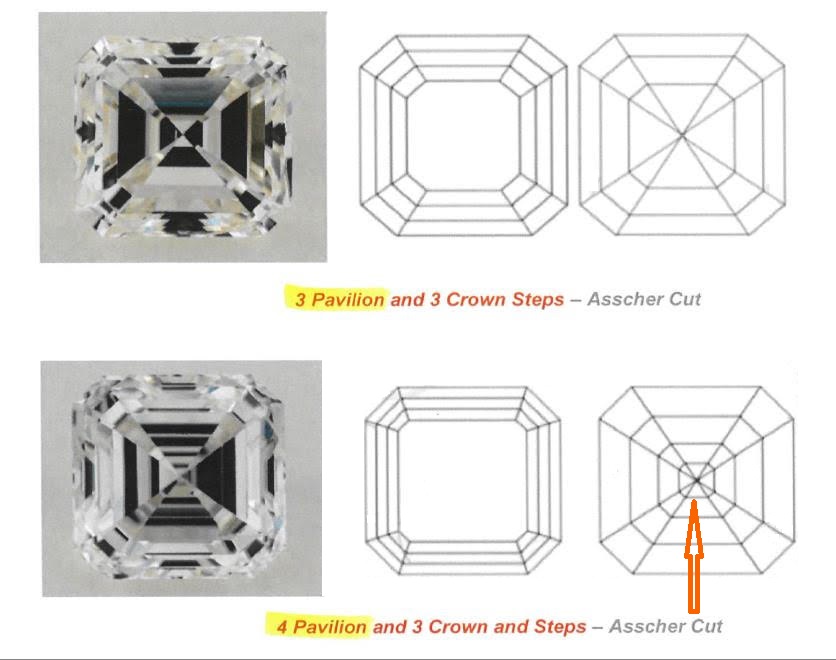
Asschers are squares with clipped corners and alternating dark/light steps of facets. They can have wide corners, making them look more octagonal. Or, they can have small corners, making them look like a trimmed square. Those in the jewelry industry tends to prefer wide cornered Asschers. However, it is completely personal preference!
Not really – they “shimmer” more than they “sparkle”. Asscher cuts are made to exude an understated elegance. They were not designed to maximize sparkle. So if “sparkle” is your goal, check out a square radiant! Square radiants have the same outline as an Asscher – a clipped corner square – but, they also have brilliant facets for max sparkle.

In addition to standard parameters (white, eye clean, depth of less than 70%, table less than 68%), the best Asscher cut diamonds have evenly spaced steps, with alternating contrast/brilliance, and “windmill” effect corners. Unfortunately, these more nuanced quality factors are not listed on the GIA Report. But, you can learn them easily! Check it out:
Asschers require evenly spaced “steps” to maximize beauty. Otherwise, they look uneven and distracting. So, in order to make sure your stone has even steps, take a look at the spaces between them. Are they about the same width? Or, are some of those facets wider than others? For maximum beauty, make sure those facets are about equal.
The next step (heh, get it?) is to look for alternating dark/light steps in your stone. Yes, you read right – you actually want some darkness in your stone. That is what gives your stone shimmer! “Contrast” is the dark background that makes “brilliance” (the white areas) pop. In fact, stones without enough contrast look “dead” and do not shimmer. You can see that here:
The best Asschers have an undulating “windmill” effect, created by the corner facets connecting with the middle of the diamond. And, it looks like one of those charming Dutch windmills! Almost all Asschers have windmill effect, however be on the lookout for the random stone whose corner facets stop short of the point (culet). Lack of windmill effect is sometimes this is okay. But many times the lack of windmill effect creates a watery dead zone. So, always check for your contrast! And make sure you like the pattern.
Ooh La La: Step cut square stones with sharp corners and no windmill effect are called “carre” (KAY-ray) diamonds.

Emerald cuts are typically long and rectangular, whereas Asscher cuts are square! That’s the easy answer. But then what is a square emerald cut? Are they the same as an Asscher? Kind of, and both will say “Square Emerald Cut” on their certifications. And, while Square Emerald and Asscher are very frequently used interchangeably, technically, they’re not the same. True Asscher diamonds have a higher crowns (tops) and smaller tables than Square Emeralds, offering more rainbow shimmer. “Royal Asschers” have 74 facets. And, Square Emerald cuts tend to be a bit less even and a bit less square (over 1.03 ratio).
Not in theory, however, because Asschers are rarer than Emeralds, you may pay more if you’re not willing to wait for a value. Both Asschers and Emeralds require a higher color and clarity to be “white and eye clean”. So, you’re probably looking at G+ color and VS1+ clarity. This is a little higher than brilliant cut stones (like Round, Oval, etc.) require to be white and eye clean. As a result, Asschers and Emeralds can be more expensive than other brilliant cut stones. So, if you find yourself a gorgeous G/VS1 Asscher, jump on it!
Yes! Asschers make up less than 1% of diamonds available on the market today. And, well cut Asschers are a small percentage of even that. So, finding a gorgeous Asscher can take a second. But when you do, they’re drop dead gorgeous. Want more help finding a stunning, rare Asscher? Email me here with your parameters! I’ll run a custom curated search to find you the best of the best.
White, eye clean, natural Asscher diamonds begin around $3,000 on our site, and lab Asscher diamonds of a similar quality begin around $2,000. However, Asschers, like all diamonds, vary greatly in price depending upon their specific 4Cs (color, cut, clarity, and carat weight) as well as diamond origin (lab or natural)! Even small differences can make a pretty significant difference in price. You can read more about how to get the best bang for your buck, while getting a beautiful white, eye clean diamond here!
Hot Tip: Also, you can see some of our recommended natural Asschers here and recommended lab Asscher here (these diamonds have been selected based on maximizing beauty and bang for your buck!).

For sure! Drop us a note here, or email us at care@doamore.com! I love Asschers and would be happy to run a custom search for you to find The One! Just let us know your search parameters – or ask for help.
An emerald cut diamond is a rectangular diamond with long, mirror-like facets. It is a traditional cut with major historic value. There are numerous famous emeralds, including those that adorned the fingers of Grace Kelly and Elizabeth Taylor, as well Amal Clooney, JLo, and perennial favorite Victoria Beckham.
Because Emerald cut diamonds require higher color and higher clarity in order to face up white and eye clean, choosing an emerald is a way to showcase value. In this respect, high net-worth individuals enjoy purchasing emeralds because they flaunt wealth. However, you don’t need a D color flawless emerald shape like them, read on for tips on how to score a gorgeous emerald without the celebrity price.
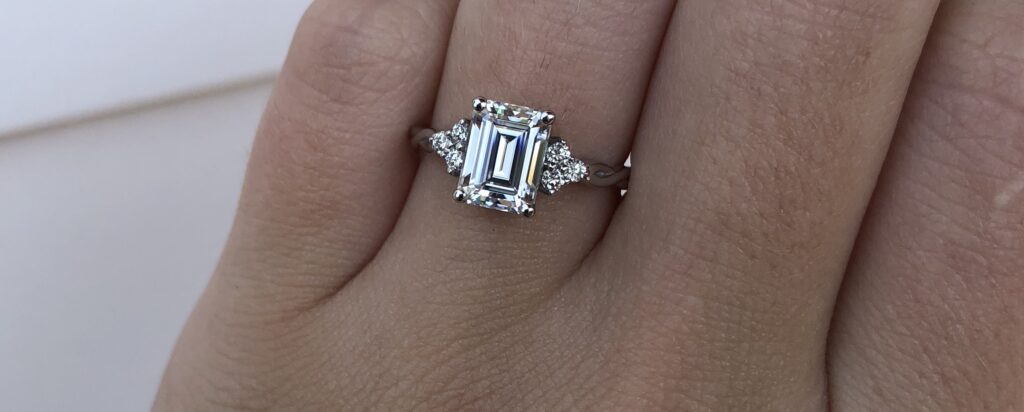
Not really, it’s more of a shine than a sparkle. Emeralds are not meant to be disco balls like other shapes. Instead, they are meant to show an understated mirror-like elegance. In fact, an emerald’s shine is called “hall of mirrors”! So, if “sparkle” is your biggest goal, try radiant instead. But if you love a gorgeous, high-end sheen, an emerald stone is for you.
The perfect emerald cut diamond is white, eye clean, and has a beautiful “hall of mirrors”. So, what is this hall of mirrors you keep hearing about? It is the light and dark bands on either side of an emerald’s table facet. These are important because in order for an emerald to have a shine, the stone needs to have some contrast to shimmer back and forth from. Otherwise, a stone can end up looking “dead”. Likewise, if the stone has too much darkness (often in the form of a “black box”) it can take away from beauty. So, you want to look for a hall of mirrors, not a box of them. Check it out:
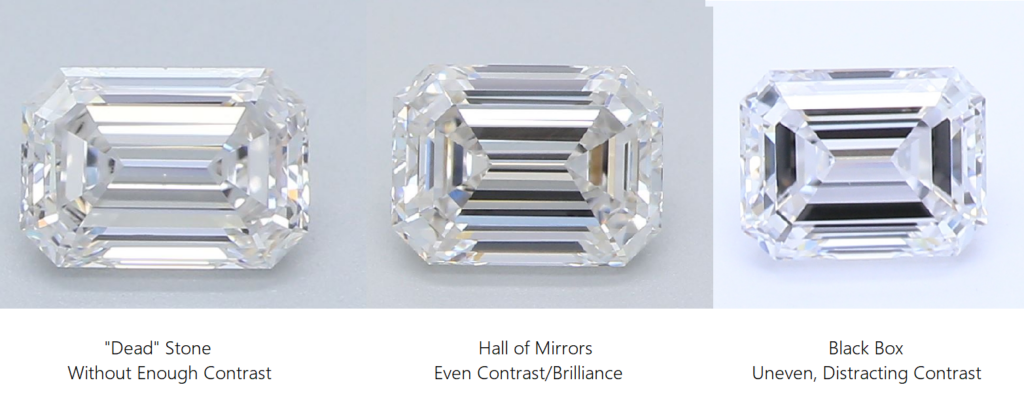
Emeralds are “step” cut stones, meaning they have rectangular and trapezoid shaped facets. Step cut stones (which also include asscher cuts) show inclusions more easily than “brilliant” cut diamonds (every other shape except emerald and asscher). As a result, couples choosing emerald cuts need to select a higher clarity than they otherwise would need to get an eye clean gem. So, which clarity should you choose? Let’s explore:
VS and VVS are higher end clarity ratings in the diamond clarity scale which starts at Flawless and ends in Included. Both VVS and VS tiers include two grades each: VVS1/VVS2 and VS1/VS2. VVS more flawless than VS, and 1 is more flawless than 2. So, the order goes VVS1, VVS2, VS1, VS2. It’s a lot of acronyms that can look a little daunting, but here’s a secret: they literally just mean “very slightly” and “very very slightly”. LOL! So, when all the letters get you down, don’t sweat it. You’ll know that “very very slightly” means there’s basically no inclusions in the stone.
Now, the distinction between these two tiers is very important in emerald cuts, as they typically need to be a minimum of VS1 in order to be eye clean. So, you will need to remember to set your filter to VS1+ (no VS2s allowed!). Then, when looking through stones, make sure that any VS1 you consider is actually eye clean (or email me to double check it!). Fortunately, VVS1 and VVS2 are almost always eye clean (only large stones could ever show an eye visible inclusion at this level).
Lab Diamond Couples: Make sure to be on the lookout for “crystal strain” in your emerald – it’s specifically noticeable in these cuts. Crystal strain is caused by the stone being grown too quickly, and looks like a “streaky” window. Not pretty, and unfortunately, not included in a stone’s certification (it can even happen in VVS stones). This only happens in lab stones. Read more here.
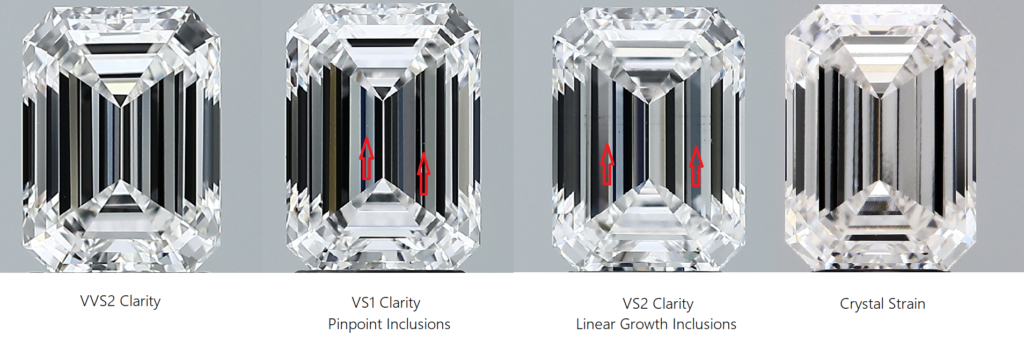
Clarity is more important, because inclusions can be seen easily in emerald shapes, and color can be hidden by gold. Because emeralds have that iconic sheen, and not inclusion-hiding sparkle, clarity has to be your first order of business. VS1+ or VVS to be sure! However – color comes in second only because near colorless shades like H and I can be masked by setting the gem in yellow or rose gold. If setting in a white metal like white gold, palladium, or platinum, you’ll still need G+ color to look white-white.
Yes, emerald cut diamonds show more color than other shapes. This is because emeralds do not have that dazzling sparkle to detract from color! In fact, the Emerald shape was originally designed to actually enhance color in colored gems like….emeralds. And, those long facets do the same for diamonds. As a result, while most shapes allow for H+ color to look “white”, emeralds really need G+ in most sizes (unless set in yellow or rose gold).
Pro tip: If you are prioritizing carat weight over color, choosing an emerald with significant contrast will somewhat detract from color. So, choosing a dramatic emerald with lots of contrast (but no black boxes!) can help.
Lab Diamond Bonus: Looking for white gold, but don’t want a warm center stone? Make sure to check out “blue nuance” diamonds in HIJ colors. Crisp icy blue instead of warm – and it looks gorgeous in white metals. Blue nuance is only available in lab created diamonds. Read more here.

Yes, emerald shaped diamonds tend to look a bit larger than other shapes due to their long length and nice spread. Unless Princess cuts and cushions, which carry their weight in their depth, emerald cuts carry their weight in their diameters. You can make sure you’re getting a good spread on your emerald by ensuring its depth is between 60-67% (just don’t give up that hall of mirrors contrast by choosing too shallow of a stone)! You can read more about the industry’s general guidelines for emeralds here.
Emerald cuts are often more expensive than other diamonds of the same size because you need to choose a higher color and clarity to look white and eye clean. However, if all other qualities are equal (for example, a G/VVS2 Emerald vs a G/VVS2 Round) the emerald will be less expensive. This is because emeralds do not waste as much of the rough gem crystal as round cuts do, and they are less in demand as rounds. So, if you’ve decided to go G/VVS already, an emerald can save you money! However, if you’re on the fence, definitely compare mid-range rounds against high-end emeralds to check value. Or email me to send you a selection within your budget!
No – emeralds and baguettes are cousins. A baguette cut is even longer and skinnier than an emerald, and has pointed corners. It also has a few less facets. Traditionally, baguette cut diamonds are used as side or accent stones, whereas emeralds are center stones. However, we have been seeing a few avant garde designers take baguettes on for sleek, modern center stones!
Emeralds and radiants have the same outline, but emeralds are step cut, whereas radiants are brilliant cut. This means that emeralds showcase that gorgeous sheen, whereas radiants show true “sparkle”. Radiants can show a “crushed ice” sparkle or a “chunky” brilliant sparkle. Both shapes are rectangular with clipped corners. So, while emeralds are an understated elegance, radiants show extreme bling. They’re both beautiful in their own right! Which do you prefer?
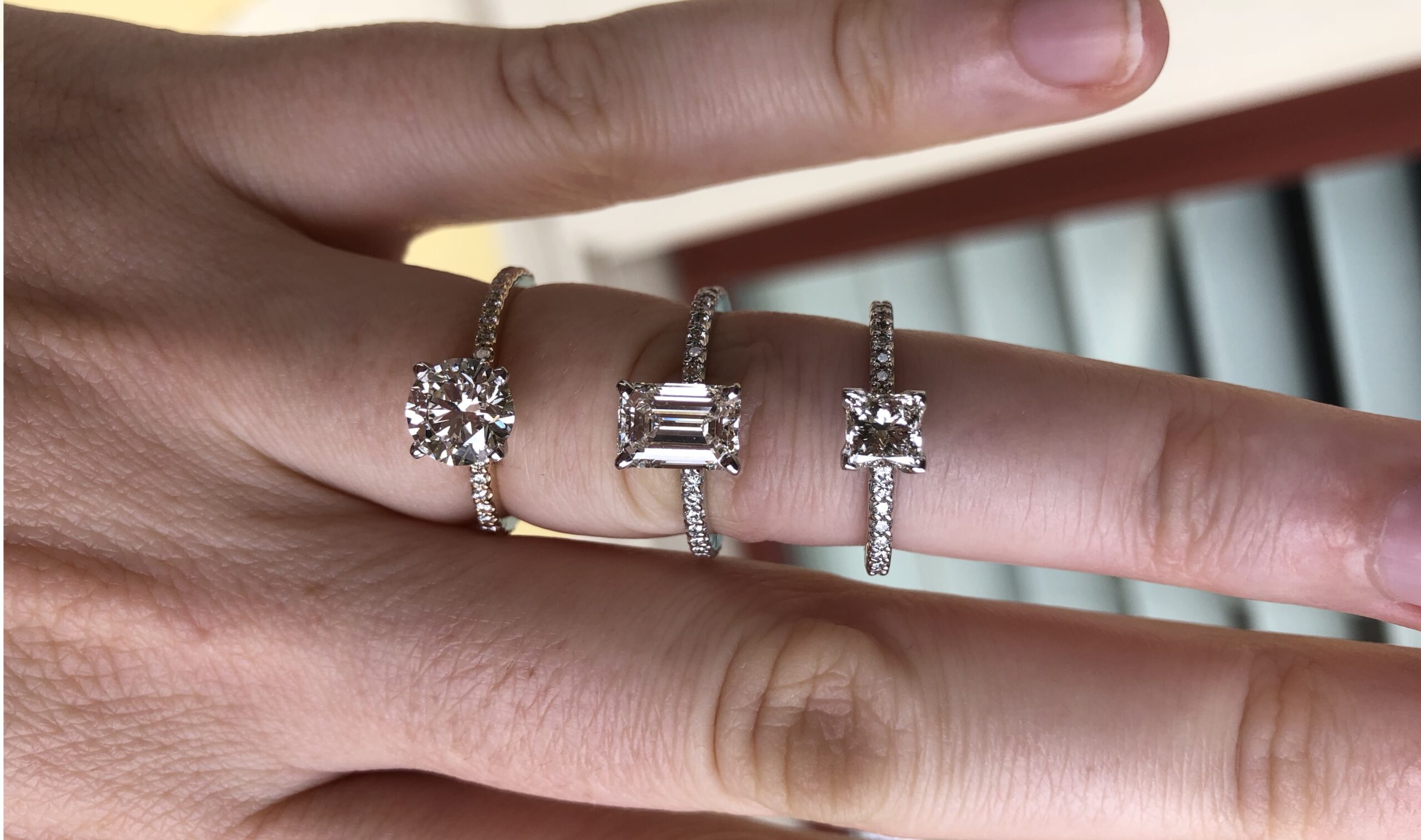
Yes! I’d love to send you a custom curated selection of gorgeous emerald diamonds for you to choose from. Just send me a note here, or email me at care@doamore.com! I can walk you through emerald hall of mirrors, color, and clarity benefits – and keep you on budget. We specialize in diamonds with max bang for your buck!
So you want major bling for your ring? I got you. When most people think about a huge diamond, a 3 carat diamond ring is what they’re imagining! This kind of carat weight packs a huge punch, so it’s a great size to go for when you’re looking for impact. However, did you know there’s ways to make a 3 carat diamond ring look even bigger and better? Read on!
Yes! The average diamond ring is between 1-2 carats, making a 3 carat diamond a big look! However, not all 3 carat stones “look” 3 carats. That’s because a “carat” is a weight measurement, not a diameter size. That also means that you can find a 3 carat stone that looks closer to 3.25 or even 3.50ct! It’s all in where the diamond carries its weight – whether that be in its bottom, or across its width. I’ll show you how to look for this below!
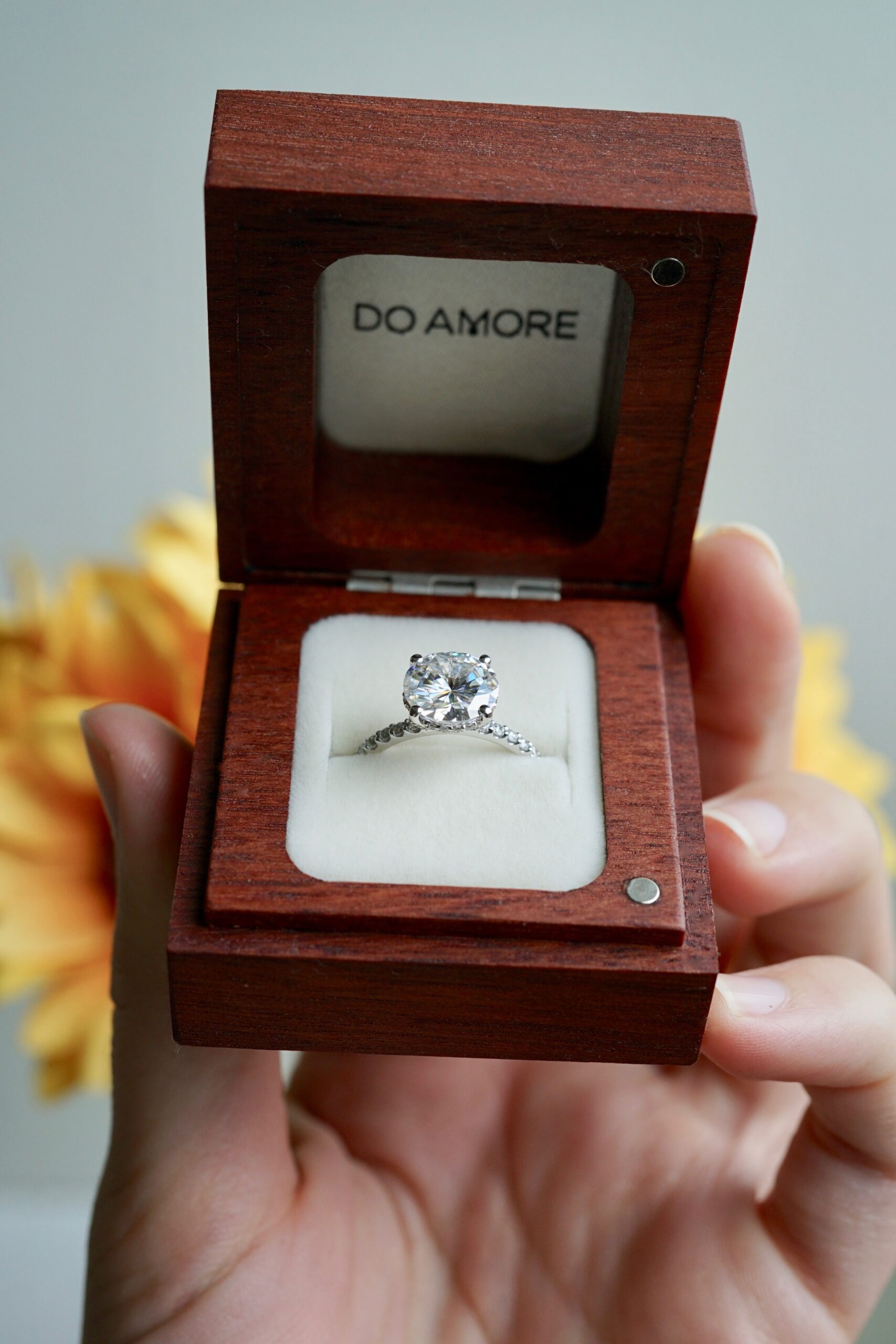
At the time of writing, a white, eye clean, natural 3 carat diamond begins around $30,000, and lab diamonds of a similar quality begin around $7,500! Diamonds vary greatly in price depending upon their specific 4Cs (color, cut, clarity, and carat weight) as well as diamond origin (lab or natural)! Even small differences can make a pretty significant difference in price. You can read more about how to get the best bang for your buck, while getting a beautiful white, eye clean diamond here! Once you choose shape, origin, and a range of color, clarity – shoot us an email at care@doamore.com. We’re always happy to run a custom search for you for the best values out there!
Pro tip: Also, you can see some of our recommended natural diamonds here and recommended lab diamonds here (these diamonds have been selected based on maximizing beauty and bang for your buck!).
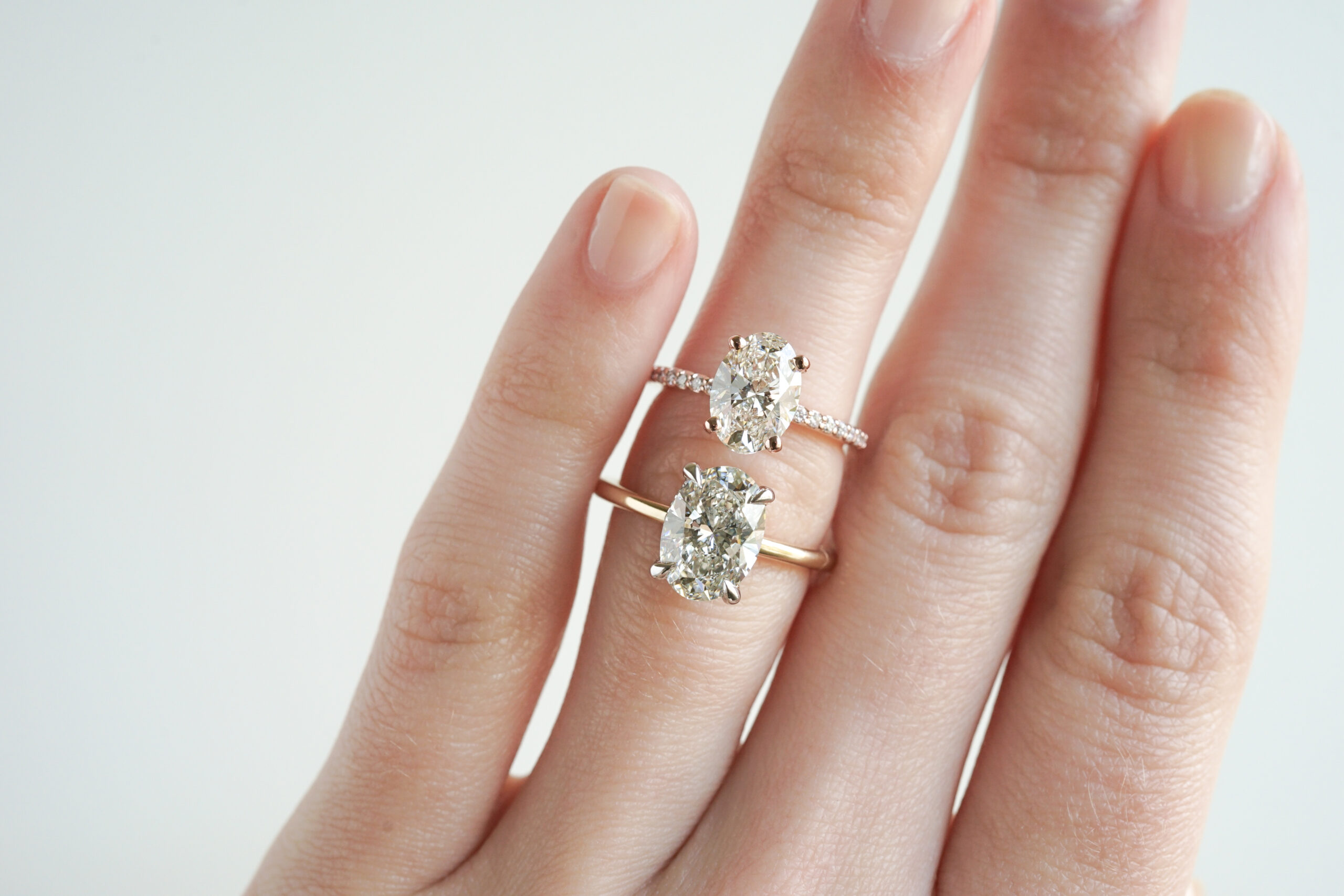
2.25ct vs 3 carat diamond ring
One way to make your 3 carat look even bigger is to choose an elongated fancy shape. Long shapes such as ovals, emeralds, radiants, and marquise look larger than their more rounded cousins. This is because their length gives the appearance of a larger surface area! So, if you’re going for max bang for your buck, choosing an elongated shape can get you an even bigger look!
Remember, “carat weight” is a weight measurement – so in order to get max bang for your buck, always look at measurements. It may be that you can get a great value by choosing a 2.9-2.99 carat that measures just as large as a 3.00-3.10ct! So, when looking for the best 3 carat diamond ring, set your filters just a hair below 3 carats, and then compare measurements. Check it out:

You don’t need a completely colorless, VVS diamond to get a big fancy look. To get the max bang for your buck, choose “white, eye clean” instead of falling for the “colorless” thing. G colored diamonds will look colorless face up! And, with the exception of emerald and asscher cuts (that mostly need to be VVS), VS diamonds are just as eye clean as Flawless and VVS stones. Don’t waste money on things you can’t see! Instead, choose G (and sometimes even H!) color and VS clarity, and then put that extra money towards more carats!
Well cut, sparkly diamonds ALWAYS look bigger than less sparkly diamonds. This is because “dead” stones without much sparkle do not really “pop” from the finger. So, in addition to looking for big measurements, always make sure to learn how to get the most sparkle from your stone too. Every shape has unique features to look for. Check out our round guide here, our oval guide here, and guidelines for emerald cuts here!
Pro Tip: EVERY shape needs even contrast and brilliance. Contrast is the dark background white and rainbow sparkle pops from! So, always look for an even smattering of dark/light in your gem to make sure it’ll sparkle like crazy!
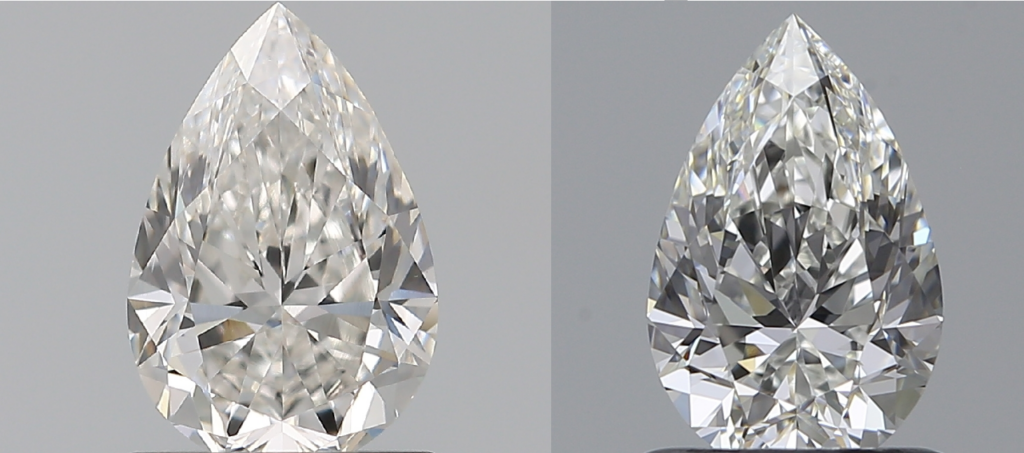
Round cut diamonds are the most popular shape, and have the most sparkle. So, it’s an easy, classic choice for a beautiful 3 carat diamond ring! Rounds are the most technically challenging cut to get “perfect” as they need very specific angles to maximize sparkle. You can learn how to master those angles and get the best Round 3 carat here.
At the time of writing, white, eye clean, natural 3 carat round diamonds begin around $38,000, and lab diamonds of a similar quality begin around $8,200. Then, simply pick your favorite setting, such as our blingy Mekelle for $1,580 in any color gold!
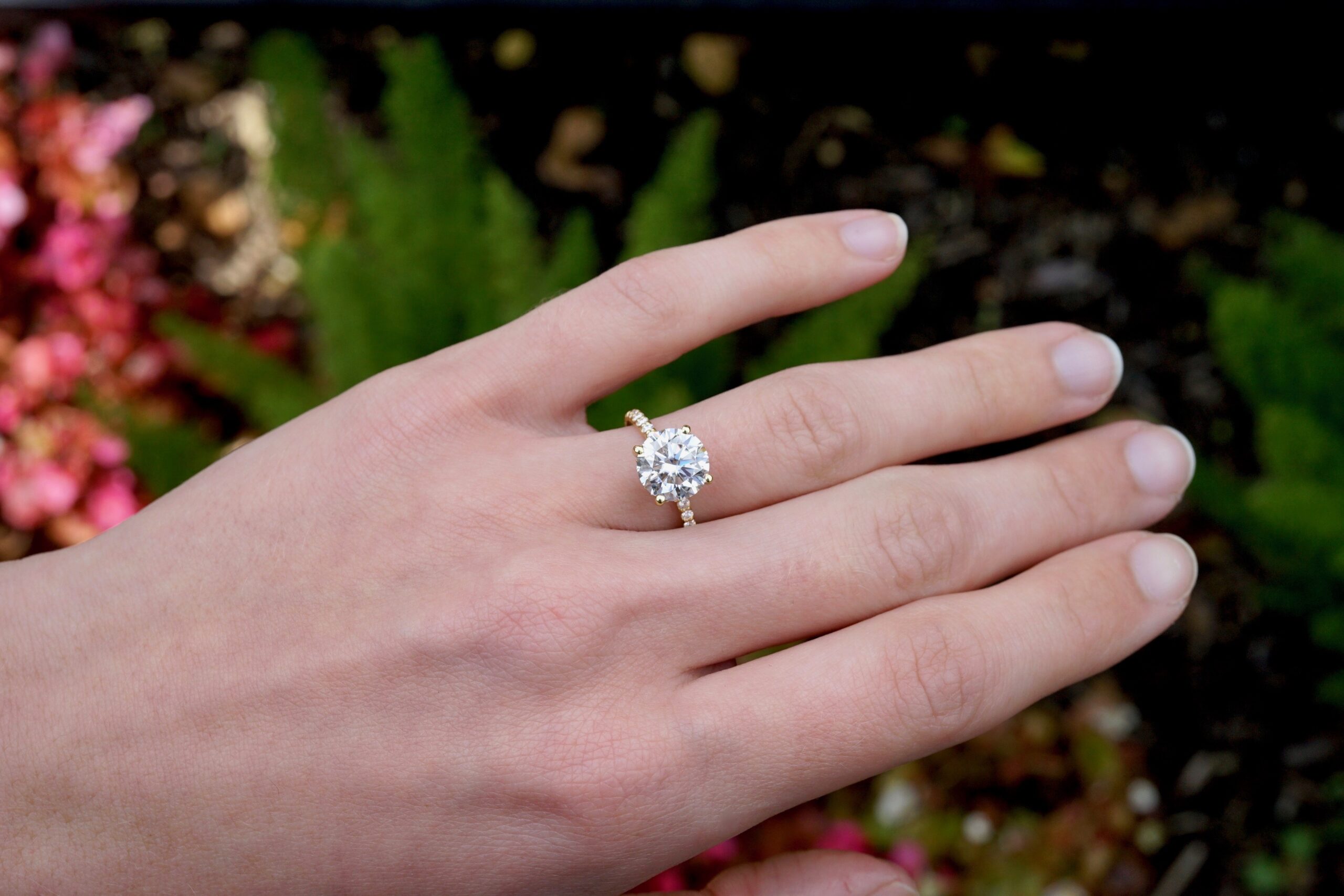
3 carat ovals look even bigger than their round cousins! That is because an oval’s nice long length gives it a larger appearance. Learn how to choose the best oval (and avoid dark bowties) here!
At the time of writing, white, eye clean, natural 3 carat oval diamonds begin around $34,000, and lab diamonds of a similar quality begin around $10,000. Choose a beautiful setting, such as our dainty Diana ($880 in any color gold)!
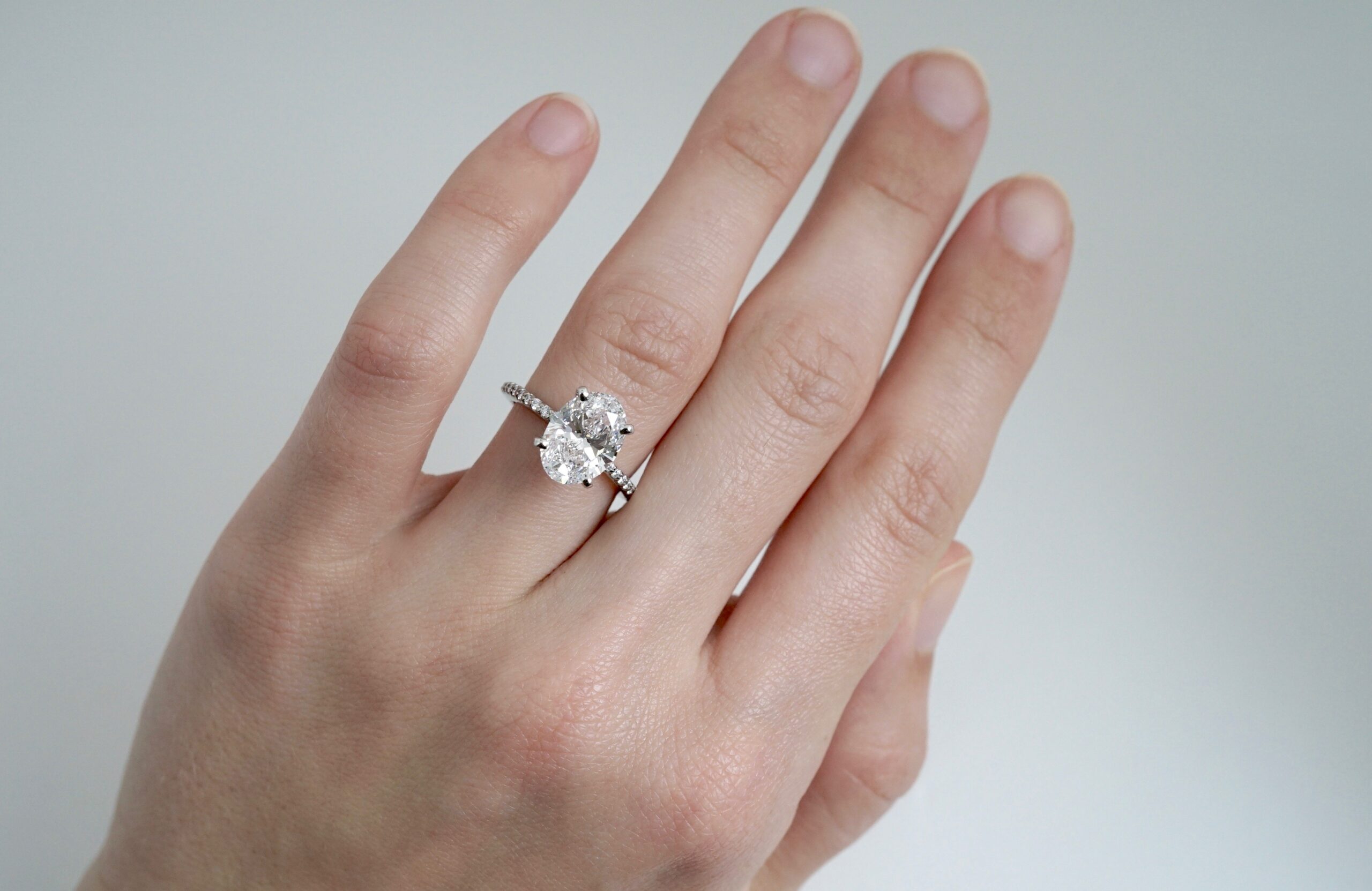
Huge emerald cut rocks are celebrity favorites! Think Elizabeth Taylor, Melania Trump, and Paris Hilton! Shining and elegant, large emerald cut diamond rings stand for high end class. That is because emerald cut diamonds require a higher color (G+) and clarity (VS1+) than other cuts to look “white and eye clean”.
At the time of writing, white, eye clean, natural 3 carat emerald cut diamonds begin around $38,000, and lab diamonds of a similar quality begin around $11,000. Choose a beautiful setting, such as our classic Asha ($450 in any color gold)!
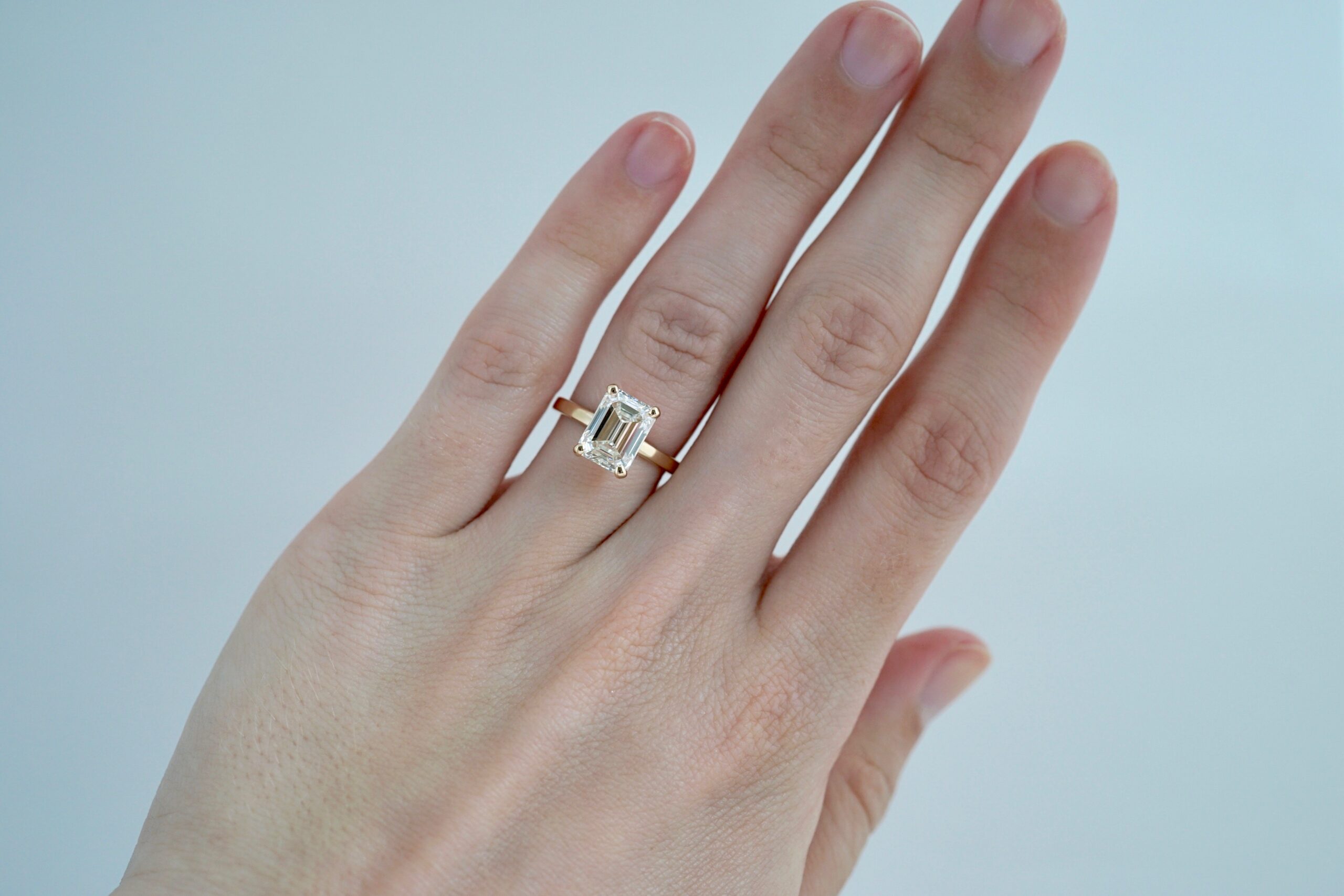
Yes! We specialize in making sure you get the biggest, best diamond for your money. You can checkout our blog dedicated to it here. So, when looking for the best 3 carat diamond ring, you’ve come to the right place. Email us here, or drop us a line here, and we’ll set out on the hunt for you!
Art Deco engagement rings have geometric patterns and often feature colored gems like sapphire, ruby, or emerald in addition to diamonds. Shapes are BIG in Art Deco. So, you’ll often see large rectangular center stones, circular or square halos, or uniquely-shaped side stones. Descriptions often used for Art Deco jewelry include bold, stately, elegant, and even architectural. Most Art Deco jewelry is done in white gold or platinum.
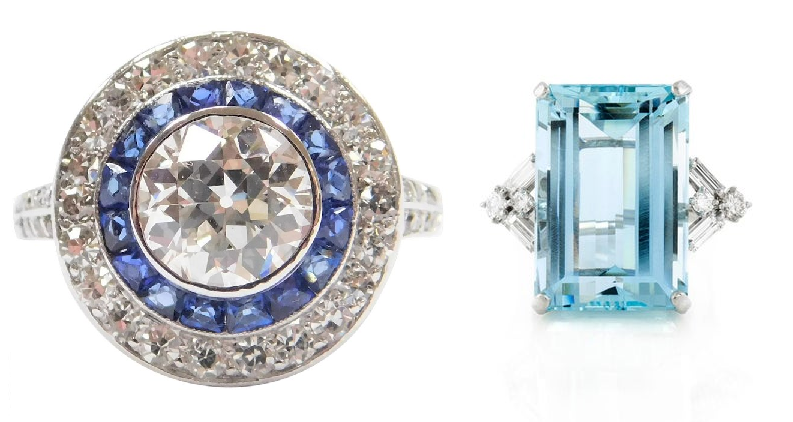
Art Deco engagement rings are popular because they make a big impression, both in personality as well as size! This is because the style’s lines and shapes are instant classics. Everyone loves a large Emerald cut, sapphire paired with diamond, and cool shining platinum. Because these looks never go out of style, they lend a sense of timeless elegance to any outfit or occasion.
Art Deco jewelry first gained popularity in the 1920s and 1930s. This was during the jazz and flapper period! Think old school glam, like The Great Gatsby and Chicago. And, as you can see, the jewelry of the age has endured. Some of the most popular engagement ring designs of today are actually Art Deco!
Yes! Art Deco engagement rings are wildly popular today thanks to a resurgence of interest in diamond halos and gemstone engagement rings. Do Amore offers several different halo designs, as well as a great selection of emerald and asscher cut diamonds, as well as some beautiful sapphire! So, if you are looking for a Deco engagement ring, you are in luck.
One of the biggest design elements of an Art Deco Engagement ring is its shape. Whether it is a large center stone, or an architecturally-inspired setting, Deco style rings feature bold shapes. Some rings feature different shapes in contrast, like a round center in a cushion halo. Other rings highlight large Emerald cut center stones stones mirrored with vertical and horizontal lines. One design element unique to Deco rings is using small square gemstones set into halos instead of tiny rounds! Another common theme is to add triangular or trapezoidal side stones to a round or square center, adding interest and flair to the piece.
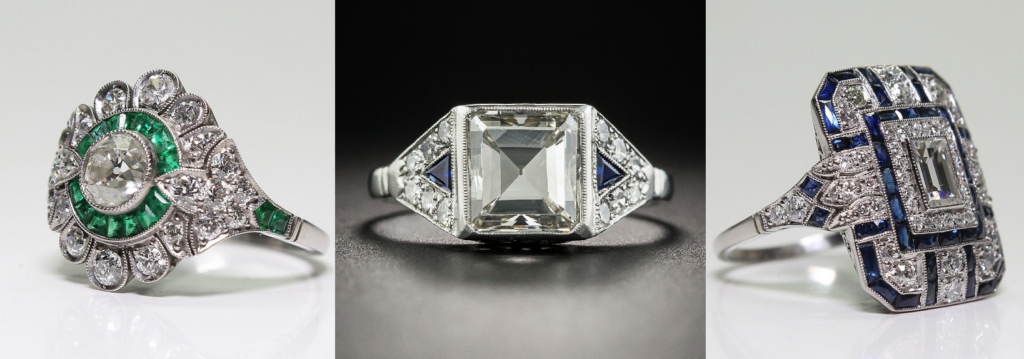
Going with the big and bold theme, Art Deco Engagement rings often feature colored gemstones in addition to diamond. Sometimes these gems are the center stone, sometimes they are placed in a bold colored halo, and other times they act as accent side stones. Popular colored center stones in Deco rings include Sapphire, Aquamarine, and Emerald. Colored bezels are typically made from Sapphire or Ruby. On the other hand, you’ll often find Emerald or Blue Sapphire accent pops.
One enduring design factor in Deco is SIZE. Ladies in the 20s were celebrating their independence and wanted to show off their style and worth. So, the Deco period was flashy! As a result, many Art Deco engagement rings are centered around huge stones. Luckily, you can do this with any budget! Aquamarine or Lab-Created Sapphire or Ruby are very affordable, even in large sizes. Don’t want a big rock, but still want to rock the look? Another way to accomplish a flashy Deco look is to choose a big geometric setting for a smaller stone, like a halo in round, cushion, or even square.
Did you know? A large portion of authentic from-the-20s Deco rings are man-made Sapphire. It’s true! Lab-created gemstones have been around for centuries
Art Deco happened in the 1920s and 30s, when platinum was all the rage. In fact, white gold was invented during this time as a less expensive platinum substitute for those who could not afford the rare metal. While a few Deco pieces are kicking around in yellow gold, the majority of Art Deco jewelry is platinum or white gold. This preference shift began around 1900, at the end of the Victorian period which loved yellow and rose. Wanting something fresh and new after a 70-year trend, Edwardian and Art Deco fashionistas embraced ice-cool platinum.
Art Deco jewelry is very geometric and bold, whereas Art Nouveau features flowing, nature-inspired motifs. As in any shift in style, there are crossover pieces. But, in large part, Art Deco jewelry is meant to make a statement. Art Nouveau, on the other hand, is more sensual and flowery. Art Nouveau jewelry often includes floral patterns, flowing colored enamel, and delicate metalwork. Deco, as you know, is more brash and linear.
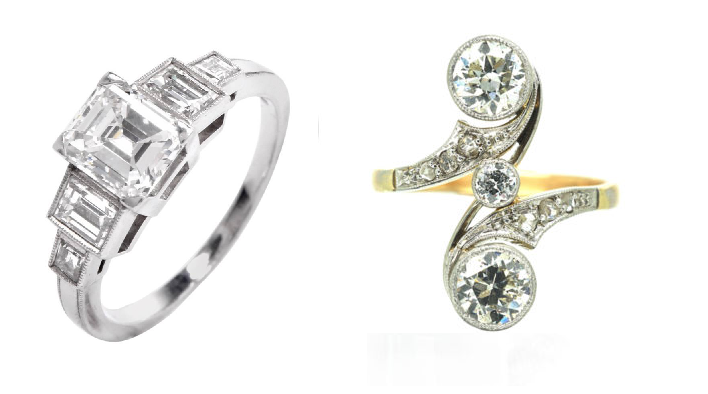
(Left) Art Deco vs Art Nouveau engagement rings (Right)
The Great Gatsby, and the fabulous jewels it constantly inspires, are classic examples of Art Deco Jewelry. Note the cushion halo around Daisy’s round diamond engagement ring, and all the straight lines and circular motifs in her headband? Tiffany’s collection, made specifically for Baz Luhrmann’s 2013 hit, also features intricate geometric colored stone rings and necklaces.
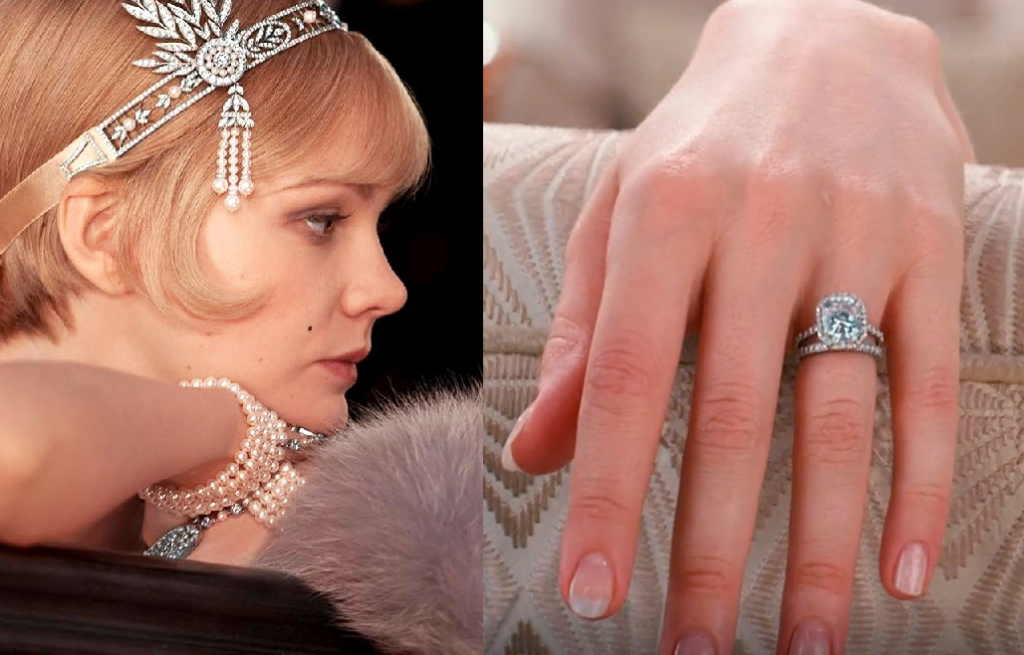
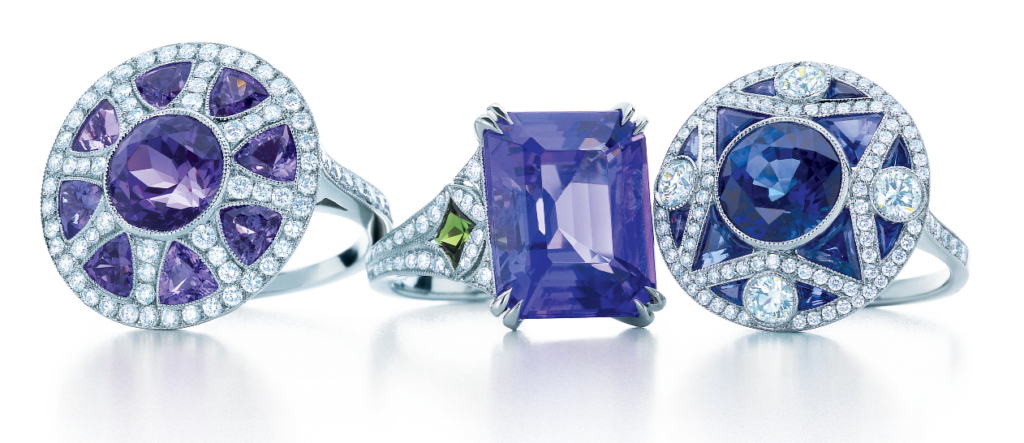
Credit: Tiffany & Co.
We can design great Art Deco engagement rings starting at $809! Here are a few other ideas:
Or, you can go completely custom. We’ve done everything from simple hexagonal bezels to intricate diamond snowflake halos!
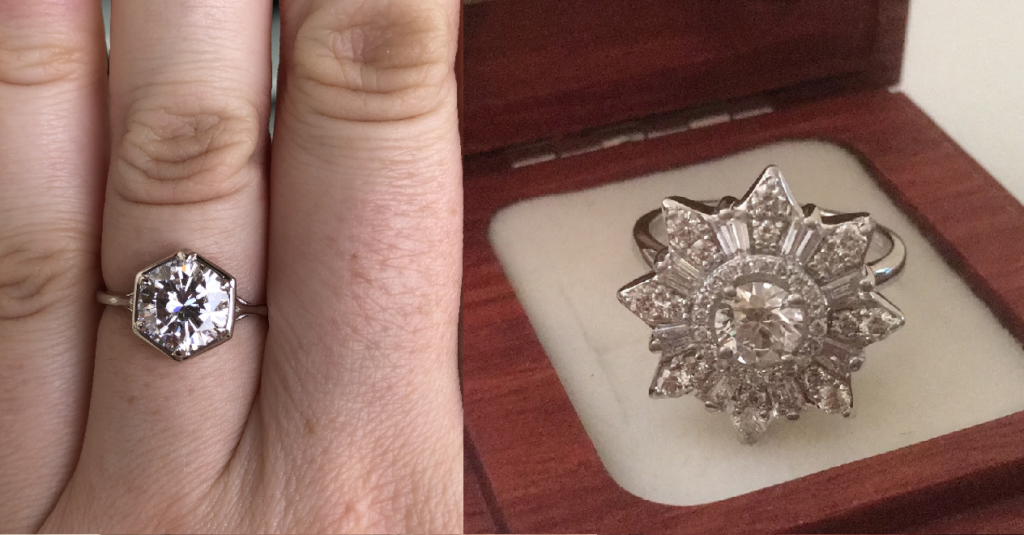
No, the value of a diamond comes from its 4cs – color, cut, clarity, and carat weight. Generally speaking, an old cut diamond such as an old European, old Miner, Rose, or “Transitional” cut will not be any more expensive than a modern Round brilliant. In fact, they are often less due to lower current demand. That said, old cut diamonds have a particular appeal to them (I love old cut diamonds). They can be both difficult to originally source and difficult to replace! But, we love them all and have made some gorgeous rings with old diamonds.
Bonus! Using an old diamond is super sustainable – no new mining needs to take place to build your ring when you choose an old diamond!
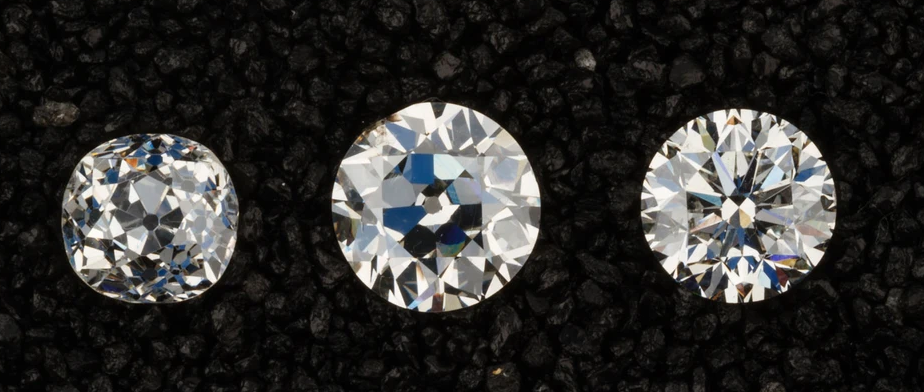
Old Miner (left); Old Euro (middle); Modern brilliant (right)
Another reason to choose an old cut diamond is that many have warmer body colors (think J, K, L…even S, T, U)! This is because back when they were originally faceted, bright white LED lights just weren’t around. Instead, people gazed at their diamonds by warm candlelight. So, warmer toned diamonds were just as desirable! What’s great about that for you is these lower colored stones are much less expensive. And not only will choosing an old cut diamond get you a great deal, you’ll also get your pop of Art Deco color too!
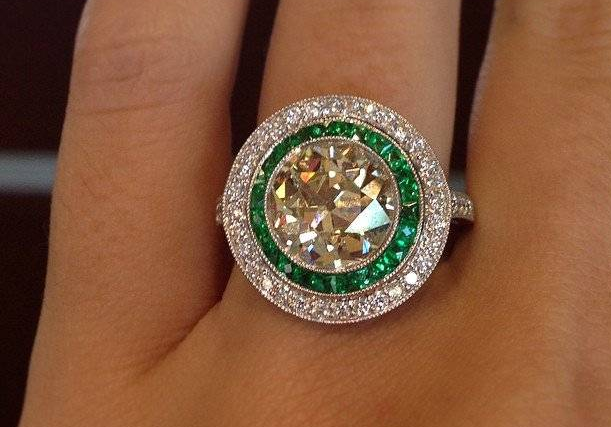
We have Art Deco engagement rings already designed – or you can design your own Deco ring! Choosing a current design and modifying it to your liking is the quickest, most cost-effective method. To do this, choose a Cushion halo with your choice of Round center stone like our Sophie, or a vintage linear setting with a huge emerald cut, like our Katherine! You can choose an icy white diamond or moissanite, or pop in some color with a Sapphire, Aquamarine, or Emerald center stone. If custom design is more your thing, we’d be happy to make the Art Deco ring of your dreams! Simply email us photos, links, or a sketch to care@doamore.com for a prompt quote. You can also drop us a note here, too!
Congratulations! You’re getting engaged! It’s such a happy time. However, it can also be a stressful one. How do you choose the right engagement ring? What diamond shape is best? How do you make sure it’s worth what you pay? There are so many questions. Luckily, there are some tips and tricks along the way to make sure you pick the perfect diamond shape for your taste and your finger. Let’s explore.

Round diamonds are exactly what they sound like – diamonds with a circular outline. Since their creation, Round diamonds have been the most popular shape in the world. They are classic and timeless. They are also the most brilliant! In fact, gem cutters and mathematicians have spent decades refining the Round brilliant to make them the most sparkly diamond out there. This is because, out of all the diamond shapes, the facets of a Round Brilliant are the most ideally aligned. In other words, when light enters an ideally proportioned Round Brilliant, it bounces around within the gem, and then almost all of it sparkles back out at you, multiplied!

Luna Engagement Ring with 6.4mm Round Diamond
Anyone who wants MAX sparkle. Round diamond shapes are great for, literally, everyone. Because of their maximum sparkle, almost all couples will love Round cut diamonds. Also, because the shape is so popular, almost all settings will accept a Round diamond shape. So, even if a couple wants a more angular or artistic setting, a Round diamond will still likely work and be beautiful.
Because Round diamonds are so popular, they may not be the best choice for couples looking for something truly “unique.” So, if your main goal in your engagement ring is to be different – a Round diamond shape is probably not what you want. Luckily there are at least 9 other diamond shapes out there!
Couples choosing a Round diamond shape should look for an Excellent cut, “eye clean” clarity (usually SI1+), and “white” color (usually H+). In addition, be sure to look at the measurements of your stone to make sure they are maximized within carat weight. In other words, you want the biggest looking stone for your buck! Check out our Round diamond buying guide for more info on how to select the best Round.
Couples that love Rounds should also check out Ovals and Cushions before settling on their diamond shape. Both Oval and Cushion diamond shapes have soft curves with great sparkle, just like Rounds. However, Cushions and Ovals are often less expensive than Rounds of similar quality. And Ovals often look larger.

Round vs Oval vs Cushion Diamond Shapes
Princess cut diamonds are square stones with straight edges and 90-degree corners. So, they are very modern diamond shapes. They are “brilliant” cut stones, meaning that they have triangular and kite-shaped facets that produce a lot of sparkle. The modern Princess cut was designed in 1980, and it is one of the newest diamond shapes to be developed. Of the “square” diamond shapes out there, Princess Cuts use the most diamond rough. As a result, Princess cuts are often less expensive than the other square shapes.

Charu Engagement Ring with 6.2mm Princess Diamond
Couples who want a more modern look. Because of its straight edges and hard corners, Princess cut diamond shapes are best for couples looking for a lot of sparkle, but with a more modern look than a Round diamond. Because of Princess cut’s popularity, couples looking for instant recognition from friends and family will also like Princess cut’s appeal.
Princess cut diamond shapes are the second most popular diamond shape searched for today. So, couples looking for something “unique” may wish to look at less common square shapes, such as Radiant or Asscher. In addition, couples concerned with classic appeal may wish to consider a shape with a more well-established history. Because the Princess cut is a relative newcomer, there have not been many celebrity Princess cuts, or highly recognized Princesses, to cement its timeless appeal. So, if this is a concern for you, you may wish to consider a Radiant diamond that has a high-status history.
One of the most important things in choosing a beautiful Princess is making sure the stone has even contrast. A great Princess will be lively when rocked back and forth, showing light and dark flashes. Another thing to consider is color. Princess cuts can show color more easily than Rounds, so look closely for color. Finally, as with most diamond shapes, maximize your measurements! Carat weight is how heavy a stone is, not how it measures. So, look for wide and tall measurements within Ideal parameters! Check out our Princess cut diamond buying guide for more info on how to select the best Princess.
Couples that love Princesses should also check out Radiants and Asschers. Both Princess cuts and Radiant diamond shapes have modern, straight edges and great sparkle. Radiant cuts have a longer history, and grace more high-end engagement rings, than Princess cuts. Asscher cuts are square stones with a unique mirror-like sparkle, they are quite rare.
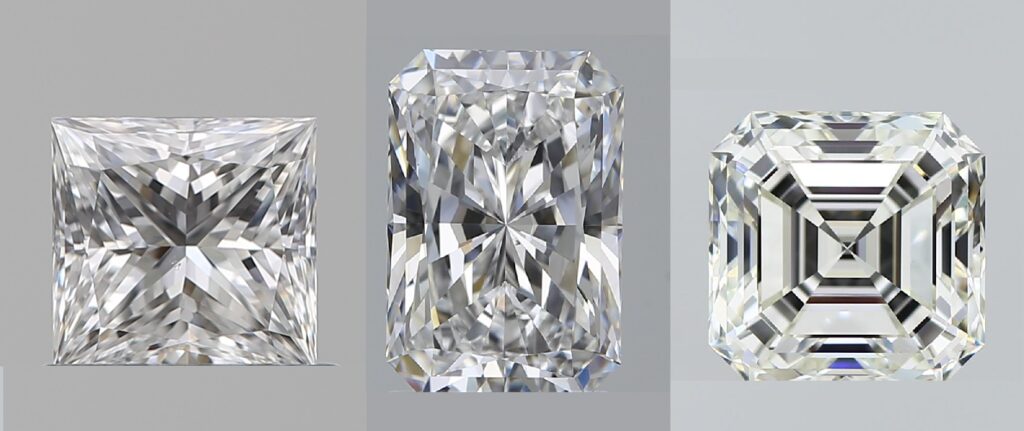
Princess vs Radiant vs Asscher Diamonds
Cushion cut diamonds are square or rectangular diamonds with soft, rounded corners – like a pillow! Cushions were the first “brilliant” diamond shape to be developed, straight out of the mines. This traditional faceting is still sought after today. In addition, newer faceting patterns have been developed which show a “crushed ice” type of brilliance. As a result, all Cushions are different.
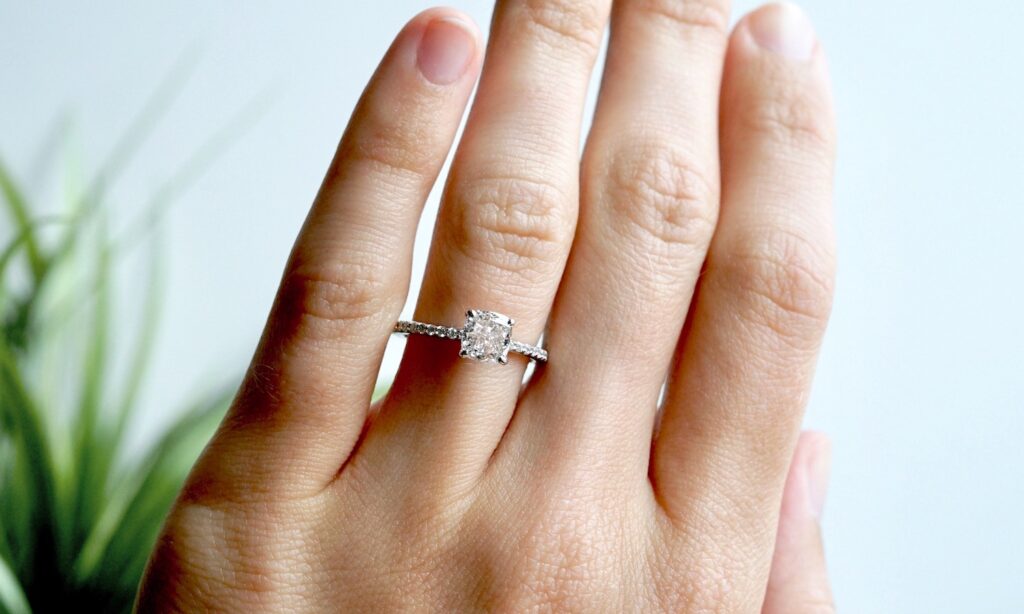
Diana Engagement Ring with 6.1mm Cushion Diamond
Because of its vintage history, many couples that choose Cushions also love other antique things. Do Amore’s gemologist, Corinne, has a Cushion and loves all things vintage. As it is a brilliant-cut gem with soft lines, Cushions also appeal to couples seeking a “different” look while maintaining a traditional vibe. Finally, a Cushion diamond shape’s big flashy sparkle often also attracts playful couples, looking for something more whimsical.
Cushion diamond shapes are notorious for being cut pretty deeply. Not all, but many. So, if size is your number one priority, a Cushion is maybe not the best shape for you as you’ll have fewer options. Couples that want a big, elongated look should also consider an Oval.
Because of the multiple ways Cushion cuts are faceted, couples choosing Cushions should first decide whether they like vintage big flash, or crushed ice brilliance. Also, because Cushions are often cut deeply, couples should make sure to maximize their measurements within carat range. In other words, make sure your diamond isn’t carrying all its weight at the bottom where you can’t see it! Check out our Cushion cut diamond buying guide for more info on how to select the best Cushion.
Couples that love Cushion diamond shapes should also check out Radiants and Ovals. Both Ovals and Radiants are brilliant cut, like Cushions, and have a unique look. Whereas Ovals are softer shapes than Cushions, Radiants are more modern. Both give a unique, elongated appearance.

Elongated Cushion vs Oval vs Radiant Diamonds
Oval cut diamonds are cut much like Rounds, with an elongated shape. First designed by Ideal Diamond creator Lazare Kaplan in 1957, Ovals are “brilliant” cut. This means they produce a bunch of sparkle! Because of their long, slender shape, Ovals often look larger than Rounds of the same carat weight.
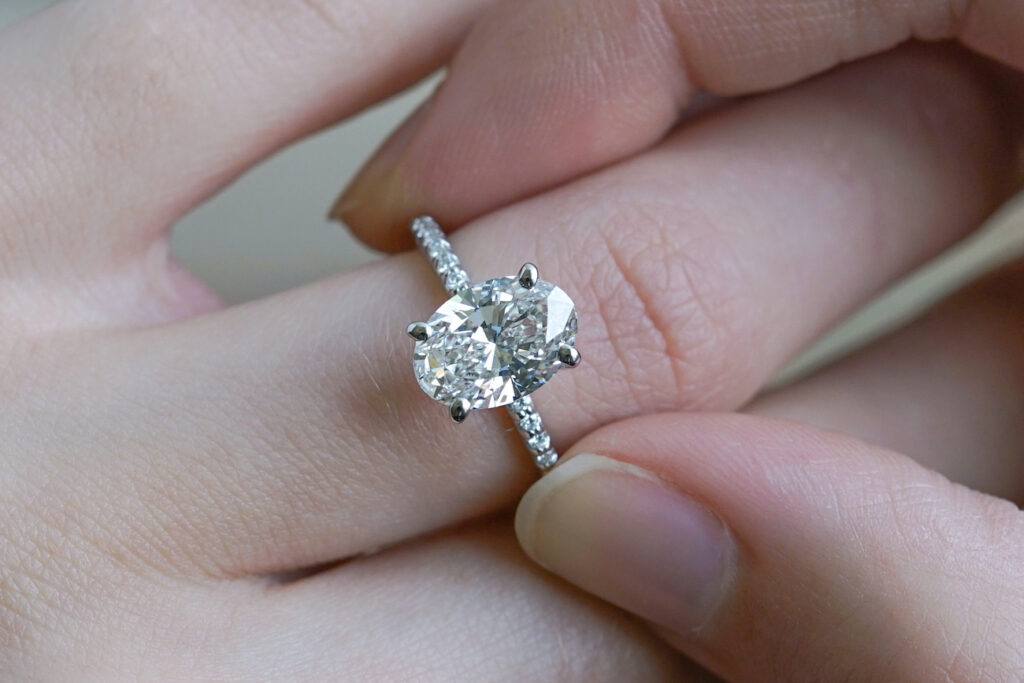
Diana Engagement ring with 10x7mm Oval Diamond
Because of its familiar shape and traditional lines, Oval diamond shapes are a lovely choice for couples who don’t want something super traditional, but still want something classic. Do Amore’s founder, Krish, proposed with an Oval diamond!
Oval shaped diamonds are a classic, traditional choice. In other words, couples looking for a more edgy, modern look will not find it in an Oval. Instead, couples should seek out hard-edged diamond shapes like Princess, Radiant, and Emerald.
Oval cuts can show a dark “bowtie” shadow in the center due to its long shape, so couples should look for gems that do not have bowties. Also, Ovals can show more color in their top and bottom than other shapes, so look out for consistent color as well! Finally, look for a pleasing outline. The Oval shape is why you love the stone – make it pretty! Click here to learn about length-to-width ratio and how to choose a pleasing Oval shape in our Oval diamond buying guide.
Couples that love Ovals should also check out Marquise and elongated Cushions. Just like Ovals, Marquise stones are graceful, slender shapes that elongate the finger. And, Marquise cut diamonds look even larger than Ovals of the same carat weight! Elongated Cushions are rectangular gems with soft corners. So, this diamond shape will also appeal to couples looking for a slim outline. Cushions and Marquise sparkle a bit differently than Ovals do, so comparing these gems side-by-side is a great way to confirm you really want an Oval!
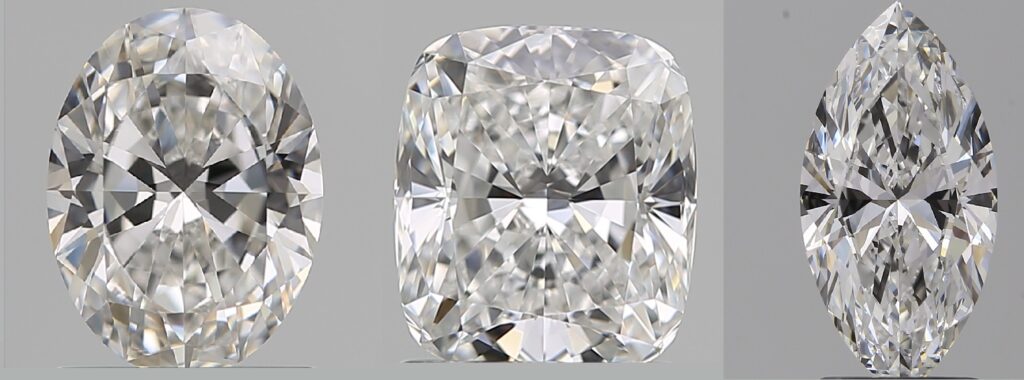
Oval vs Elongated Cushion vs Marquise Diamonds
Emerald cut diamonds are long, rectangular diamonds with facets that create a “hall of mirrors” effect. They are the first of two “step” cut diamonds we will discuss. Step cuts are faceted much differently than “brilliant” cut diamonds. Instead of the traditional “sparkle” you see in most diamond shapes, Emerald cuts glimmer. They were designed to showcase color and high clarity. In other words, their sparkle does not mask inclusions or slight color tint like other diamonds. For this reason, they are a popular choice for high-end engagement rings.
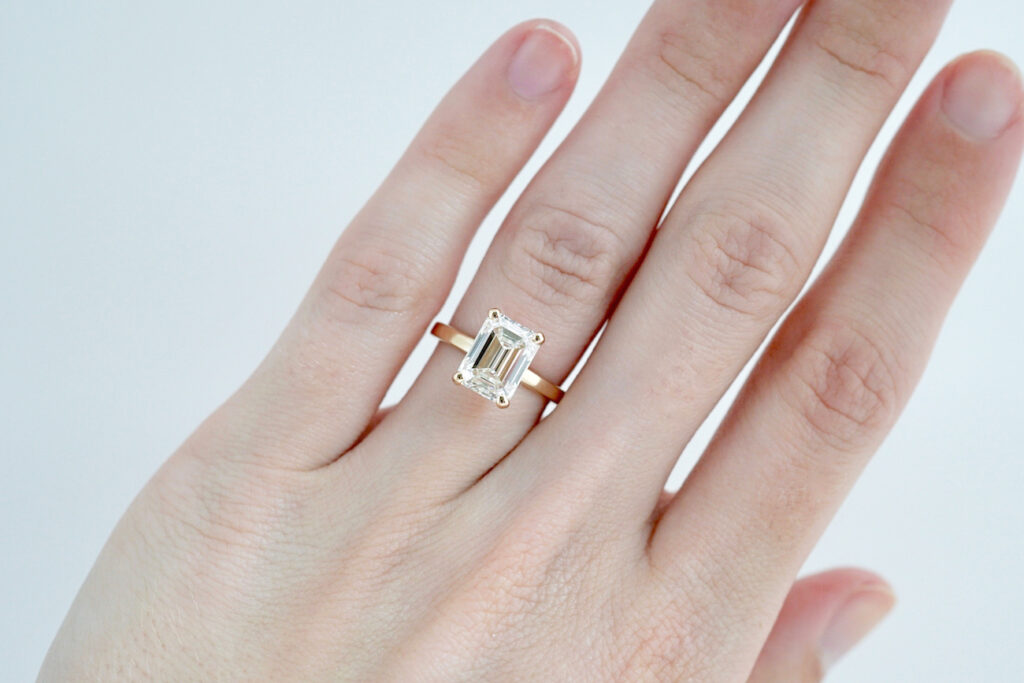
Asha Engagement Ring with 9.5x7mm Emerald Diamond
With its soft mirror-like glimmer, Emerald cuts are a great choice for couples wanting something more subtle. An Emerald cut’s elegant, old-world glamour is also an excellent choice for those who want their engagement ring to exude high-end quality. Because of its color and clarity needs, the best Emerald couples are those that don’t mind spending a bit more on their center stone.
The big takeaway about Emeralds is that they do not “sparkle.” So, if maximum sparkle is your goal, an Emerald cut is not for you. Couples looking for a rectangular, sparkly stone should check out Radiants. Also, because of its necessary high color and clarity, couples looking for bang for their buck will not find it in an Emerald.
Emerald cuts can show a dark “black box” in the center due to its mirror faceting. So, when rocking an Emerald cut back and forth, look for vertical dark and light play, without a boxy horizontal dark area. Because Emeralds show inclusions so easily, always remember to pay close attention to clarity. Most Emerald cuts need to be at least VS1 (and often VVS2+) to ensure eye clean clarity. Click here for more tips and tricks on choosing a great Emerald-cut!
Couples that love the rectangular look of an Emerald, but want more glitz, should check out the Radiant cut. Radiants are “brilliant” diamonds with the shape of an Emerald! For those that love the glamorous look of an Emerald, but also need a better-priced stone, check out an elongated Cushion. Elongated cushions, especially those that are more traditionally faceted, give a soft glimmer similar to an Emerald. But, because Cushions are brilliant-cut, couples can often get away with lower color and clarity, making them a more affordable choice than Emerald. Finally, those that love Emeralds will also love the lesser-known Asscher cut. Asschers are square Emerald cuts!

Emerald vs Radiant vs Elongated Cushion vs Asscher
Radiant cut diamonds are long, rectangular diamonds with bright, sparkly facets. First faceted in the 1970s, Radiant cuts are the well-kept secret of rectangular diamonds. Not often shown in brick and mortar jewelers, Radiants have been chosen and worn by celebrities for decades. There are several faceting patterns available in Radiants. However, all include wide, clipped corners, like an Emerald cut.
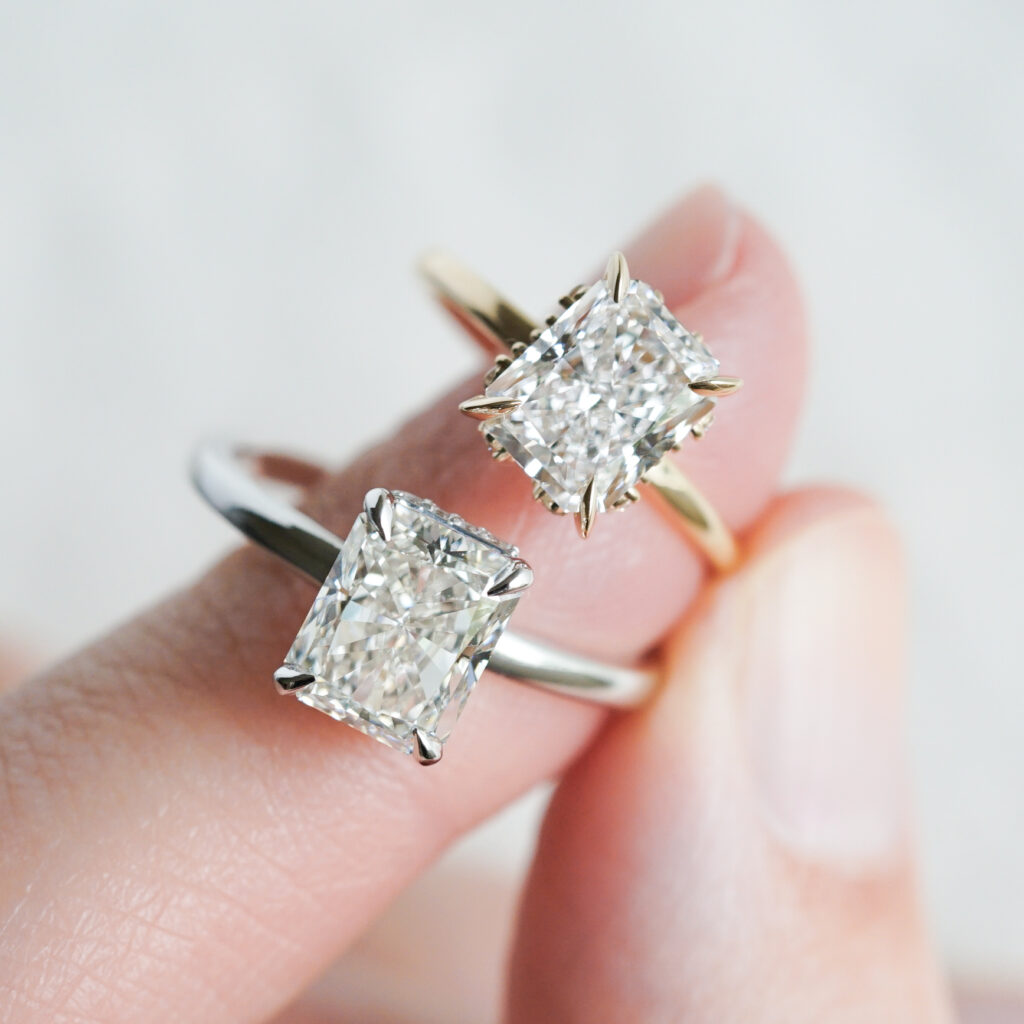
7.5x6mm Custom Radiant and 8x6mm Radiant in Jolie Ring
Radiants are a great pick for couples looking for something a little edgier than a traditional round, and who also want their stone to have great sparkle and established “cred.” Because Radiants have a history as a high-end choice, couples can feel confident choosing a Radiant. Because of its rarity, Radiants are a great choice for those looking for something unique. Finally, Radiants are a great rectangular choice because they don’t need super high color and clarity to look gorgeous.
A Radiant cut’s shape is quite edgy. It has hard lines and clipped corners. So, couples looking for a soft look will not find it in a Radiant. Also, because of its rarity, many people have never heard of Radiant cuts. As a result, couples looking for immediate recognition won’t get it in Radiant, and may wish to look at Princess cuts.
Radiant faceting can either show a more traditional facet pattern, or a “crushed ice” type of look. So, when looking for a Radiant, decide which one of these looks you’re going for first. Also, crushed ice Radiants can show color much easier than other shapes. So, pay attention to color in the top and bottom of the gem, where this “ice” is. You want consistent, white color. For more tips on choosing a great Radiant, check out our Radiant cut buying guide.
Couples that love the rectangular look of a Radiant should also check out elongated Princess cuts and Emerald cuts. Elongated Princess cut gems will give a similar look and will be less expensive than a comparable Radiant. To ensure you are getting the look you want, couples should also check out Emerald cuts, which have the same outline, with very different “sparkle.” Emerald cuts give more of a mirror-like sheen in comparison to Radiant cut’s sparkle. Finally, couples who love the “crushed ice” look of a Radiant should also consider an elongated Cushion, as certain Cushions also show this effect.

Traditional Radiant vs Emerald vs Elongated Princess vs Crushed-Ice Radiant
Pear-shaped diamonds look like a raindrop (or a hot air balloon!) They can be plump, skinny, or traditionally proportioned, depending upon the shape of the rough and the preference of the cutter. They can be worn with the point up, or down, based upon the wearer’s preference. The Pear shape was first designed in the 1400s! So, it has quite a bit of history to its name. Due to its brilliant faceting, Pear shapes give great sparkle.

8x5mm Pear Diamond in Elle ring
Pear shapes are unique in that they are asymmetrical. Whereas the top is an edgy point, the bottom is a graceful curve. So, those looking for a unique or artsy look will love it! This gives the wearer an option to change up the ring’s look simply by turning it upside down. They can also be set sideways or on a diagonal for a truly artistic expression.
Pears are lovely and unique. However, because of their asymmetry, Pears are not very traditional. As a result, this uniqueness makes them not the right choice for everyone. So, if you are looking for a classic, traditional engagement ring, a Pear shape may not be the right fit for you. Also, if part of your diamond shape decision is the stone’s “investment quality,” you may be better off with a more traditional shape like Round, Cushion, or Radiant.
Pear cuts can be slender, traditionally proportioned, or more chubby. I personally love a nice plump Pear. The most important thing is to make sure the shape is graceful. So, the curves should be soft, without pointy areas. And the point should be pointy – else you’ll have an egg! Finally, as color can gather at the tip of a Pear, couples should always look for even coloration. For more tips on how to choose a pretty Pear, check out our Pear-shaped buying guide.
Couples that love Pear shapes may also love a Heart shape. Similar in its asymmetry and unique nature, Heart cut diamonds are a romantic comparison shape. Couples looking at Pears should also compare them to Oval shaped diamonds. Ovals are long, elegant shapes like Pears, but with even more brilliance.
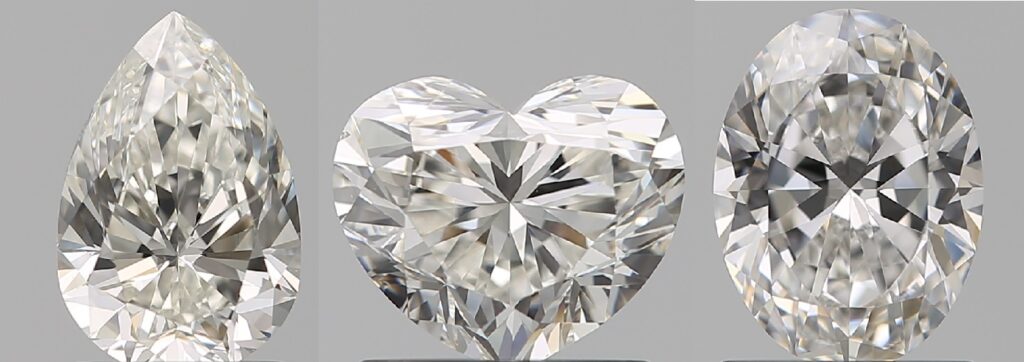
Pear vs Heart vs Oval Diamonds
Heart-shaped diamonds are just what you imagine, a diamond shaped like a Heart! They are brilliant-cut stones, which means they really sparkle. Hearts are the most romantic diamond shape, and also one of the rarest. Like Pears, they can be plump, skinny, or traditionally proportioned. Heart-shaped diamonds have been around since the 1500s and have a royal history.
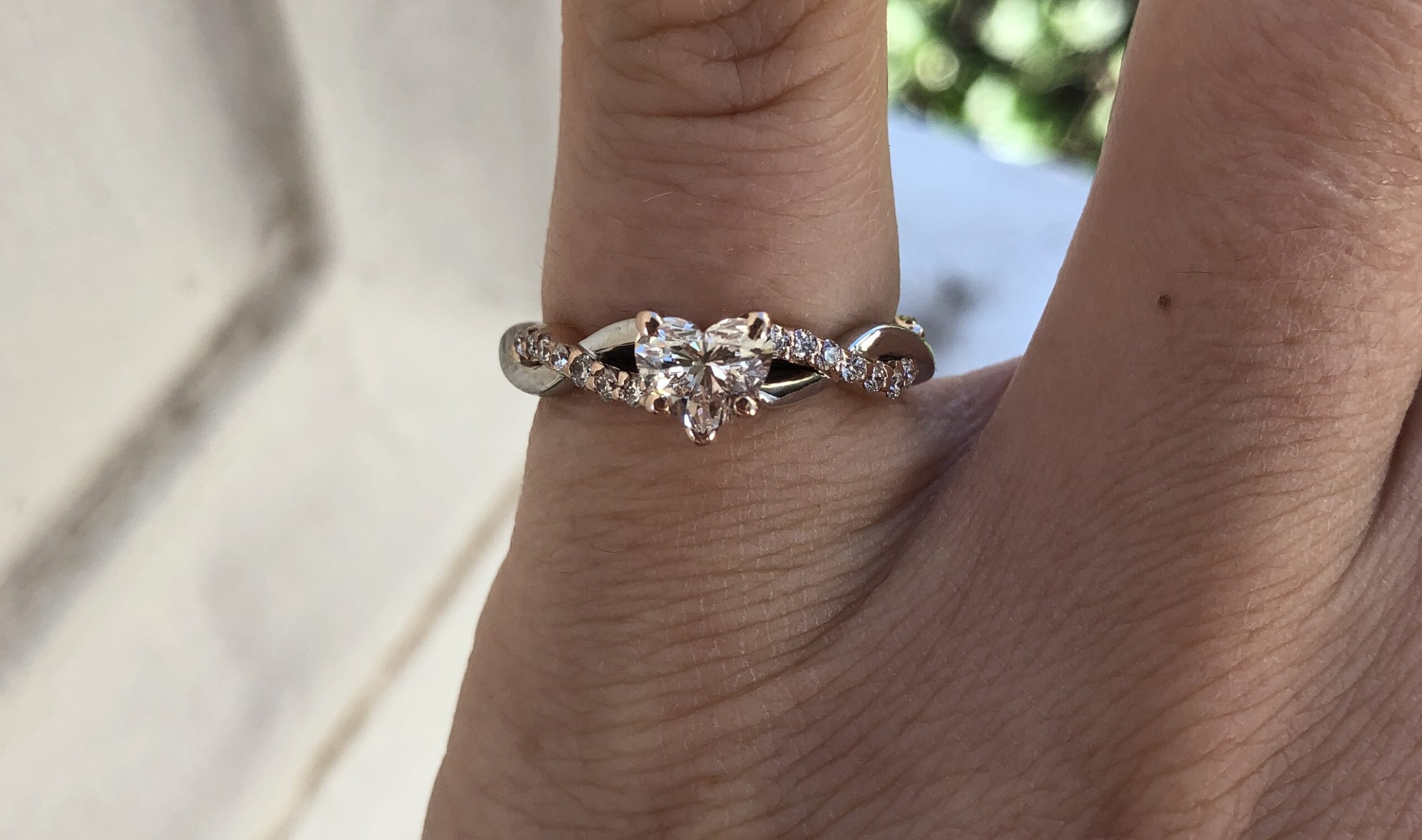
Heart Shaped Diamond in Custom Ring
Heart shaped diamonds are whimsical and unique. They are best suited to romantics that love everything about love. Couples that I know who chose Hearts love rom-coms, all things Disney, and fairy tales!
Some couples love Hearts, and others greatly dislike them. This shape is very personal. So, if you are looking for something that has universal appeal, a Heart shaped diamond is not likely your best bet. This also means that if “investment quality” is a major concern in your ring shopping, you should instead consider a Round, Cushion, or Radiant.
Couples choosing a Heart diamond shape are doing so for its great shape – so that great shape is top priority! Soft “lobes” (the curves of the Heart) and a pointy tip are very important. Hearts can be slender, traditionally proportioned, or more chubby. I tend to advise against slender Hearts, as I don’t think they are as attractive. Finally, as color can gather at the point of the Heart, couples should always look for even coloration. For more tips on how to choose a lovely Heart, check out our Heart-shaped buying guide.
Couples that love Hearts are unlikely to want any other shape. However, for argument’s sake, I tend to suggest that people compare them, just in case! Good shapes to compare with Hearts are Pears and Marquise. Plump Pears have a similar appeal to Hearts, as they are asymmetrical and unique. I also love to show a nice fat Marquise. Plump Marquise have a whimsical appeal too, much like a playing card diamond. And Marquise will look larger!

Heart vs Plump Pear vs Plump Marquise Diamonds
Marquise cut diamonds are almond-shaped stones with points on the top and bottom. They are said to be shaped like a kiss! Designed in the 1700s, Marquise are brilliant-cut gems that look larger than any other diamond shape. Greatly popular in the 1970s and 1980s, Marquise are regaining popularity today thanks to their elegant length and large sizes. Like Pears, Marquise can be slender, traditionally-proportioned, or plump. New designers have been setting them horizontally, whereas traditionally, they are worn vertically to elongate the finger.
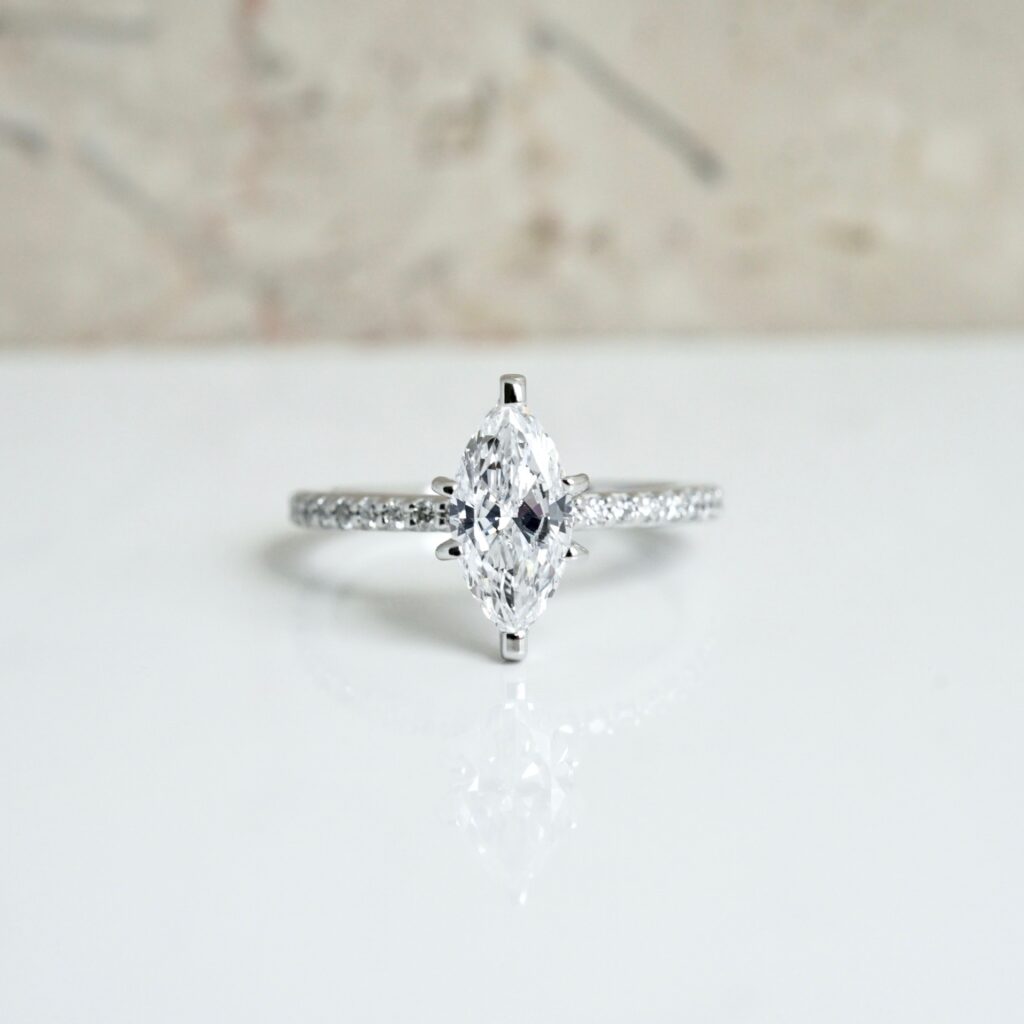
10x5mm Marquise Diamond in Diana Ring
Marquise are a rare and unexpected choice today. Because of the Marquise craze 40 years ago, some couples reject Marquise as a modern option. So, couples that like pushing boundaries may love the idea of shattering expectations with a great, modern Marquise ring. Also, a great reason to choose a Marquise is its amazing ability to look significantly larger than any other shape. So, those looking for a statement piece? They should check out a Marquise.
The Marquise’s popularity in 1970-1980 biases some people against them. Perhaps their mother had a Marquise, and they want something different. So, couples that have a pre-set notion that they dislike the shape will likely not be talked out of it. But I’ll try. Consider that Catherine Zeta-Jones’, Ashlee Simpson’s, and Portia de Rossi’s engagement rings are all beautiful Marquise!
Couples choosing a Marquise diamond shape typically do so for its elegant shape and size. So, choosing a stone with a pleasing outline is a big deal. Tips include making sure the curves of your stone are soft, not awkwardly flat or boxy, as well as that your points are actually pointy. In addition, Marquise can carry some extra color in their points, so always look for even color. For more tips on Marquises, check out our Marquise cut buying guide.
Couples that love Marquise are likely to also enjoy the appeal of Ovals and Pears. The rounded bottom and pointed top of a Pear is reminiscent of the Marquise’s outline, but a bit edgier. An Oval, on the other hand, gives a Marquise’s elegance but offers more brilliance.
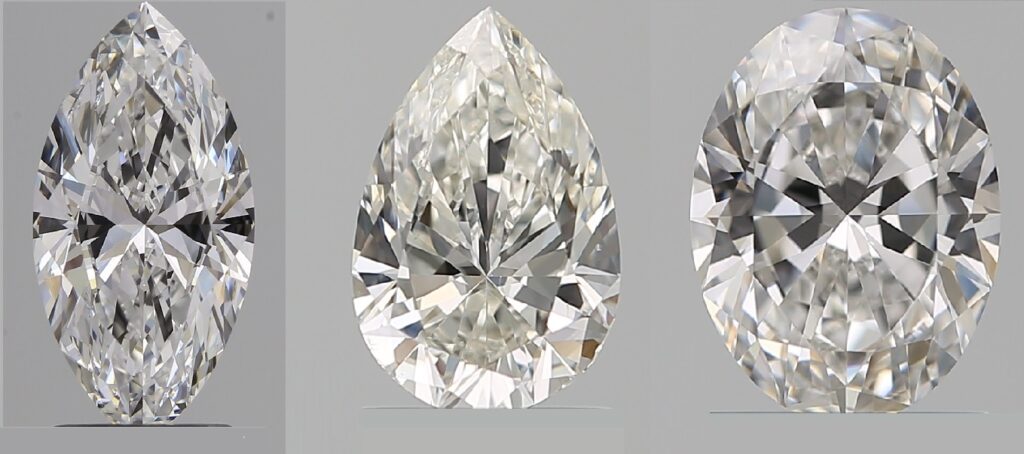
Marquise vs Pear vs Oval Diamonds
Asscher cut diamonds are square stones with clipped corners and rectangular facets that create a “hall of mirrors” effect. Born from Emerald cuts, Asschers are “step” cut diamonds, which glimmer instead of “sparkle.” Asscher cuts flash between light and dark when you rock them side to side. Like their sister cut, Emerald, Asschers show off high color and clarity. So, their faceting does not hide inclusions or color tint. Instead, they magnify them. For this reason, couples that like high-end things often love Asscher cut stones.

Asscher cut diamond ring
With its hall of mirrors effect, couples love Asschers for their simple elegance and Art Deco appeal. As they do not sparkle like other gems, they are a good choice for low key couples, and also couples who want to show relaxed status. Because Asschers require high-end color and clarity, the best Asscher couples are those that don’t mind spending more on their center stone.
Again, Asscher cut diamonds shimmer, they do not sparkle like other diamonds. So, if max sparkle is your goal, an Asscher is not your cut. Couples looking for a square, sparkly stone should check out Radiants and Princesses. Because of its high color and clarity needs, couples looking for a great bargain will likely not find it in Asscher.
Asscher cuts can show a dark “black box” in the center, due to its mirror-like faceting. So, when viewing an Asscher, look for well-proportioned glimmer without a distracting black box. Because Asschers show inclusions so easily, another thing to pay close attention to is clarity. Most Asscher cuts need to be at least VS1 (and often VVS2+) to ensure eye clean clarity. Click here for more tips and tricks on choosing a great Asscher cut!
Couples that love the square look of an Asscher, but want more glitz, should check out the Princess cut. Princess cuts are “brilliant” diamonds with a square shape! For those that love the old world glamour of an Asscher, but need a better value, Cushion may be the ticket. Vintage and shimmery, square Cushions are often a better price than Asschers. Finally, those that love Asschers will also love their sister cut, the Emerald. In fact, you may find a better price in a squarish Emerald cut, than a perfectly square Asscher!

Asscher vs Princess vs Cushion Diamonds
Sure can! I’d love to talk with you about diamond shapes, comparison shapes, and how to pick the best shape for your lifestyle and finger! Email me or send us a note here with pictures, ideas, or questions and I’ll help you choose the perfect shape for you!
Okay, get this:
Only 3% of the diamonds in the world are emerald cut. They’re among the most unique available. Yet 15% of our sales come from them. Why? We have a special knowledge of emerald cut engagement rings.
They are gorgeous. Distinct. They have an unmatched vintage look. We love matching people with the perfect emerald cut ring. If you are looking for emerald cut engagement rings, make sure to read through this first.
Here are some tips:
Your average 1 carat emerald cut diamond has 5% greater surface area than a 1 carat round cut diamond. All else the same, the top surface of an emerald cut diamond will look larger.
So, what does this mean?
This means that you can get a diamond that looks a little larger for a lower price (to see what I mean by lower price, keep reading).
Emerald cut diamonds are elongated. This means emerald cut engagement rings give the illusion of longer and more slender fingers.
Maybe this is a good thing for you. Maybe it’s not. But slender fingers do give the illusion of making you a better piano player. So there’s that.
All emerald diamonds in our conflict free diamond search engine have the length and width listed. The ratio is simply the length divided by the width. This number will help you see how narrow or wide the diamond is.
See, the larger the length to width ration is, the longer and skinnier the diamond will be. Though people usually prefer a diamond between 1.2 to 1.8, I think an emerald diamond should have a minimum ratio of 1.3 and a maximum of 1.6.
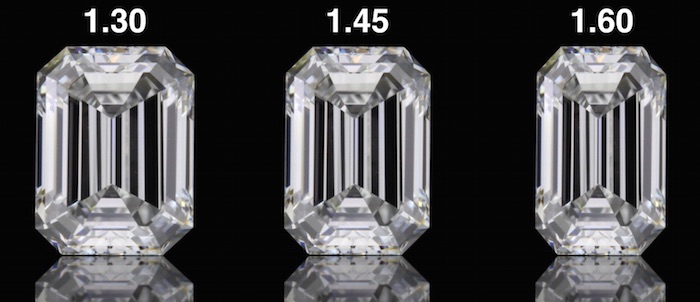
If I was buying an emerald cut engagement ring, I would choose an emerald diamond with a length to width ratio of 1.33-1.50.
Well, here’s a popular benefit:
Emerald cut engagement rings are less expensive. It’s true that they are rarer than round or princess-cut diamonds. But they’re also in less demand.
You can expect to spend 15-25% less on an emerald cut engagement ring than you would on a round engagement ring.
Something you might want to thing about:
You can see inclusions in an emerald cut engagement ring more clearly than you would in a round diamond. Make sure your jeweler will do a thorough visual inspection of the stone before you purchase it. Since you’ll save about 15-25% on your emerald cut engagement ring, consider putting that money towards upgrading your clarity level. I strongly encourage you to stay away from SI2 emerald diamonds. The inclusions will be seen with the naked eye.
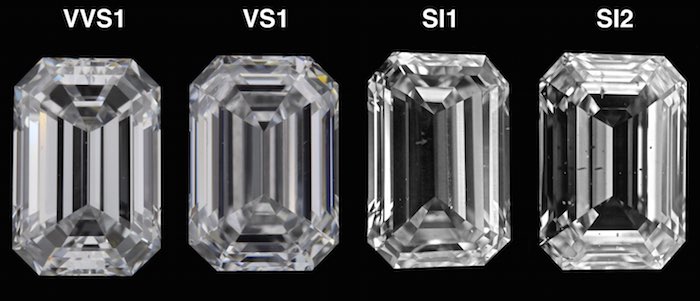
Comparing the Clarity of 4 GIA Certified Emerald Cut Diamonds
It’s easier to tell the color of emerald cut diamonds than other cuts.
Let’s talk color grades:
All colorless diamonds in the D-F range would be the same color – regardless of cut. However, a slightly warmer diamond would reveal color more easily on an emerald cut diamond. (These would be low-color diamonds in the H-K range)
If you don’t want your emerald cut engagement ring to show any warmth (yellowness), upgrade a color grade above what you would have purchased with a round diamond.

Comparing the Color of 6 GIA Certified Emerald Cut Diamonds
Let me rephrase that:
Emerald cut engagement rings just have a different sparkle to them. It’s more subtle.
An emerald diamond is cut differently than other diamonds. Most diamonds are brilliant cut, which creates sparkle and brilliance. Emerald diamonds are step cut. This creates flashes of light known as the hall of mirrors effect. It’s a beautiful illusion that creates broad flashes of white light to contrast the dark planes within each step. Despite being a step cut diamond, the corner edges of a well cut emerald diamond should still have sparkle.
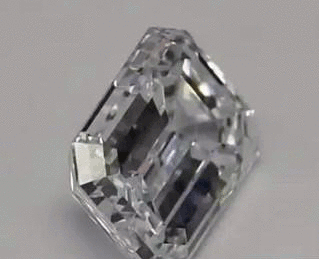
Well cut emerald diamonds have broad flashes of light in the middle and sparkle on the edges.
It’s important that your jeweler understands the optimum emerald diamond specs. The below table should help you narrow down your choices. But, never buy an emerald diamond based on the certificate only.
Find someone that can perform a visual inspection before you purchase the stone. Make sure their understanding goes beyond just numbers on a certificate.
| Ideal/Excellent Cut | Very Good Cut | |
| Table (%) | 61 – 69 | 57.5 – 60.9 or 69.1 – 72 |
| Depth (%) | 60 – 67.0 | 58.5 – 59.9 or 67.1-69.5 |
The term emerald cut is used actually used to describe the unique shape, which was developed for emerald gemstones (the green stone). Emerald cut moissanite and emerald cut sapphire are much more affordable than emerald cut diamonds.
My post on affordable engagement rings covers these options in more detail. Contact us if you want to discuss these options.
Buying online is, of course, totally fine. But pay extra attention when you’re shopping for emerald cut diamonds. Make sure your online jeweler truly understands the specifications that make a beautiful emerald cut engagement ring.
Also, always ask for a detailed picture like below.
This will allow you to get a true understanding of the stone quality. If you’re considering Do Amore for your emerald cut engagement ring, shoot us a message. We can assist you in finding a beautiful emerald diamond that’s within your budget! Since I know a lot about emerald cut engagement rings, feel free to ask for me personally (my name is Krish).
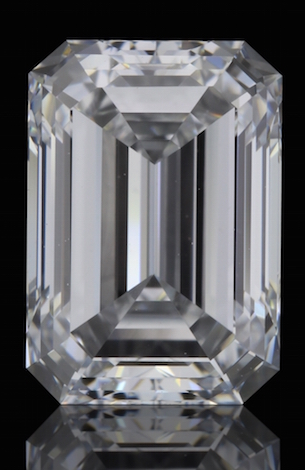
Never buy Emerald Cut Engagement Rings without seeing a close-up photo of the diamond